*[CLICK ON THE PICTURES TO GET A CLEARER & BIGGER VERSION :)]
Of what used to be a place to obtain granite is now an attractive spot for tourists (cyclists especially) to experience what it was like for Singapore during the 70s. Dragging myself up from what might seem like an ungodly hour for some (4:15 in the morn), I quickly packed and prepared for my virgin trip to Pulau Ubin. My geographical imagination of the place was that it's rather kampung-like in contrast to the urban landscape that's ubiquitous of Singapore. And that there wasn't much to see (according to some of my friends who have been there and back -__-). So, without expecting much, I hurried to catch Bus 200 since I needed to be at the Changi Village Ferry Terminal by 7:45am. (rather far east from where I am staying)
After an hour and 3 quarters of trundling down the rails and road, I reached the appointed time on dot (lucky...pheeww). And the first person I saw was none other than Hen (short for Henrietta) with Ron and Luan Keng (LK) not far behind. :)
 ___
___
(left): The waiting area. The hired bumboat doesn't move until it has the required amount of 12 passengers.
(right): A snapshot of the domestic jetty before we bid adieu to the mainland.
(right): A snapshot of the domestic jetty before we bid adieu to the mainland.
 ___
___
(left): Off on the bumboat and the fee costs about [Edit] S$2.50 per person for a journey that takes about 10 minutes.
(right): The big fiery ball that hangs up in the sky peeps shyly from behind a cloud. With the breeze soft and the warm embrace of the sun gentle, I felt that the ride ended really quick.
(right): The big fiery ball that hangs up in the sky peeps shyly from behind a cloud. With the breeze soft and the warm embrace of the sun gentle, I felt that the ride ended really quick.
 ___
___
(left): The plate number of the bumboat which the 10 of us (3 guys and 7 gals) boarded upon.
(right): The first view of the island upon touching down.
 ___
___
(left): This island is quite well-known for its bike-riding enthusiasts who can rent the vehicle for S$2 a pop. Of course, you are allowed to bring your own bikes (if wished), but that will cost you an additional S$2 for the boat ride.
(right): "Welcome to Pulau Ubin". The sign says it all. ^^
(right): "Welcome to Pulau Ubin". The sign says it all. ^^
 ___
___
(left): On to change into more suitable shoe wear. Apparently, this facility and several others around here are solar-powered. =) A great, green effort.
(right): Of course, there are also some who come here to try their luck on fishing. Whatever that rocks your boat, that's what I always feel.
(right): Of course, there are also some who come here to try their luck on fishing. Whatever that rocks your boat, that's what I always feel.
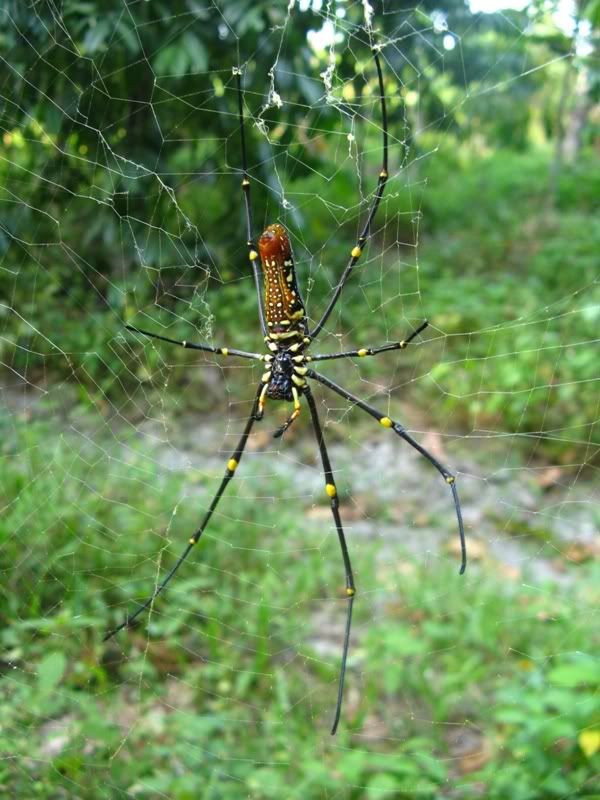 ___
___
And the first creature that we chanced upon was the rather common Golden Orb Web Spider [Edit] (Nephila pilipes). It get its name from the golden silky web which it spins. Its not the largest spider (though the picture might state otherwise), its web is the largest and the strongest. [1] And see this striking arachnid in the picture, it's a female. The females (20cm across from toe to toe) are usually the giants while the males are approximately 1/10th of its size. We can definitely see who wears the pants in the family. =)
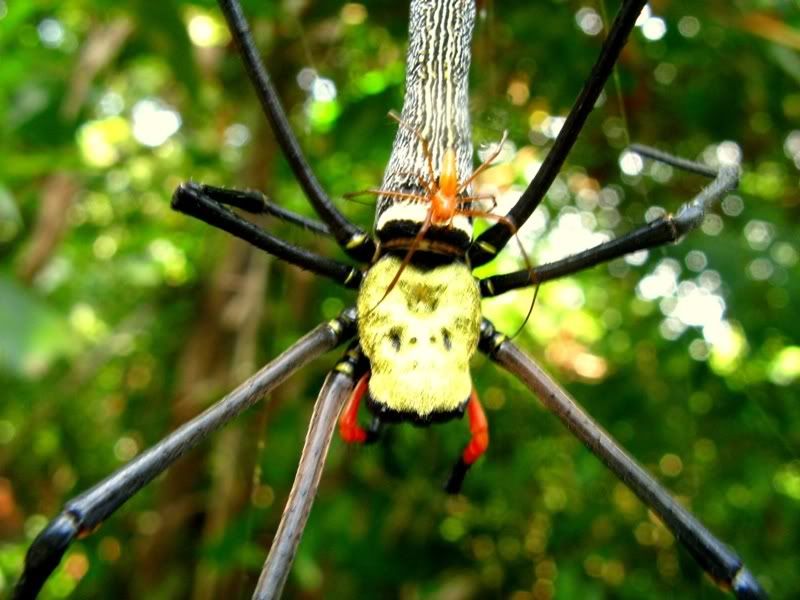 ___
___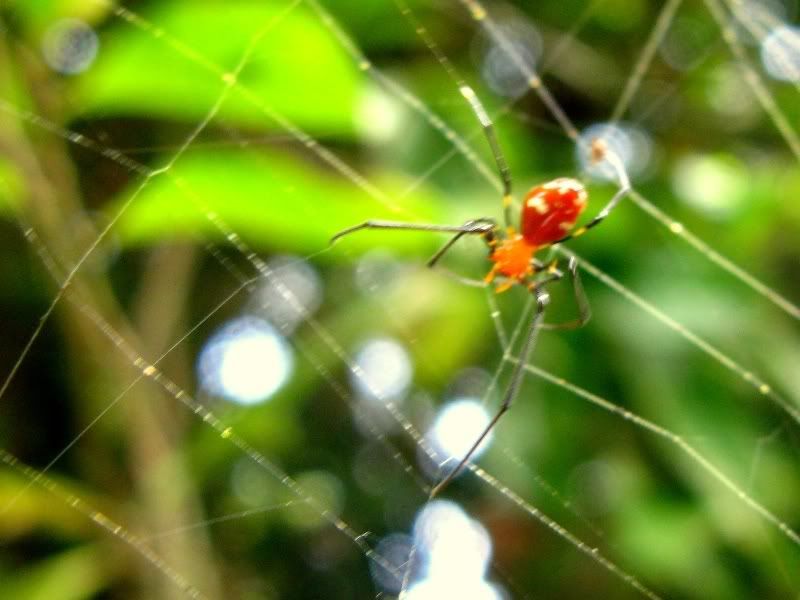
(left): The males, which are about 5-6cm in length [1], (there's one on the female's back) should not be confused with the parasitic spider that's also a red hue (on the right) in colour. The lower abdomen of the male is more slender compared to the rounded bottom of the parasites.
(right): On a single web that can reach 6m in height [1], parasitic spiders, tens (or maybe more) can be spotted at the peripheral of the silky trap.
(right): On a single web that can reach 6m in height [1], parasitic spiders, tens (or maybe more) can be spotted at the peripheral of the silky trap.
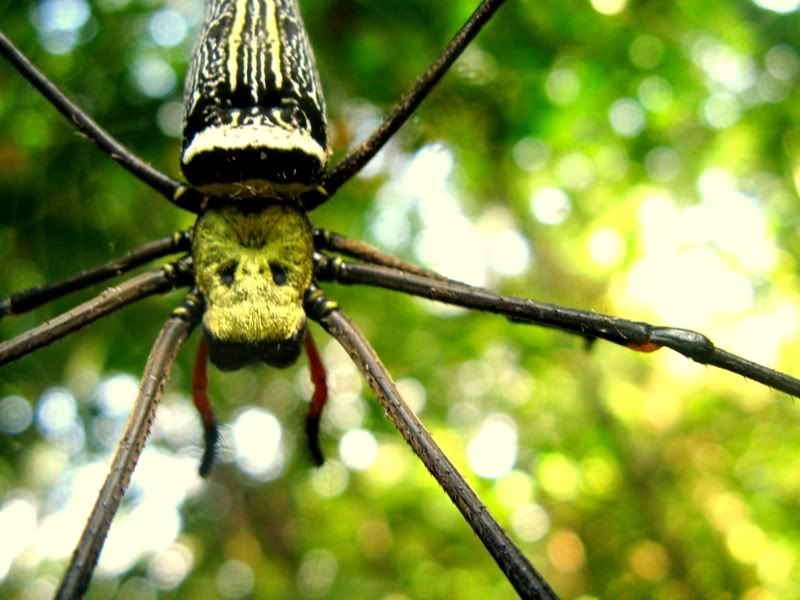 ___
___
(left): A close up on the female which I inadvertently startled and send it scurrying up the tree which it was on. Spiders of these kind usually spin a barrier web to alert it of incoming threats so that it can make a quick escape if needed. The barrier's generally smaller than the ones used to trap prey. A mini web, if you like. It's either that or a thread connected to the main web.
(right): Besides the variation on the left, there was also a red variation of the Golden Web Spider.
(right): Besides the variation on the left, there was also a red variation of the Golden Web Spider.
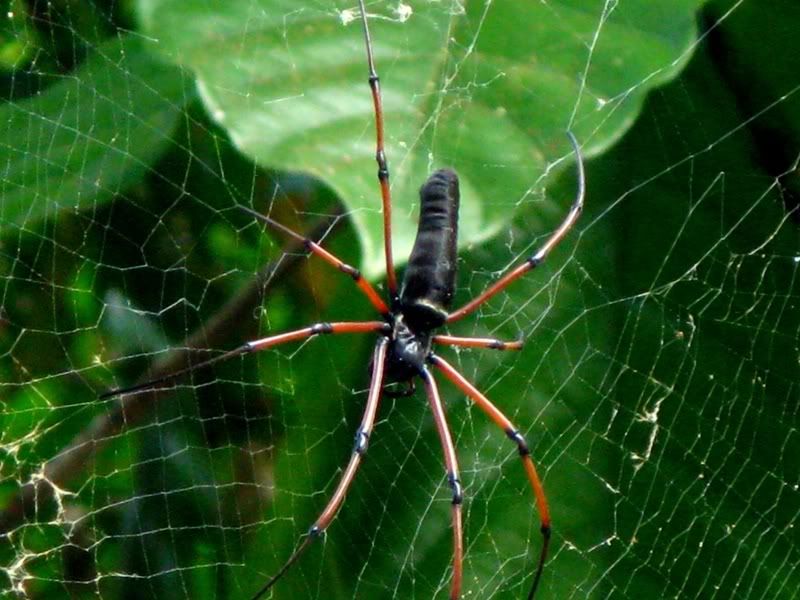 ___
___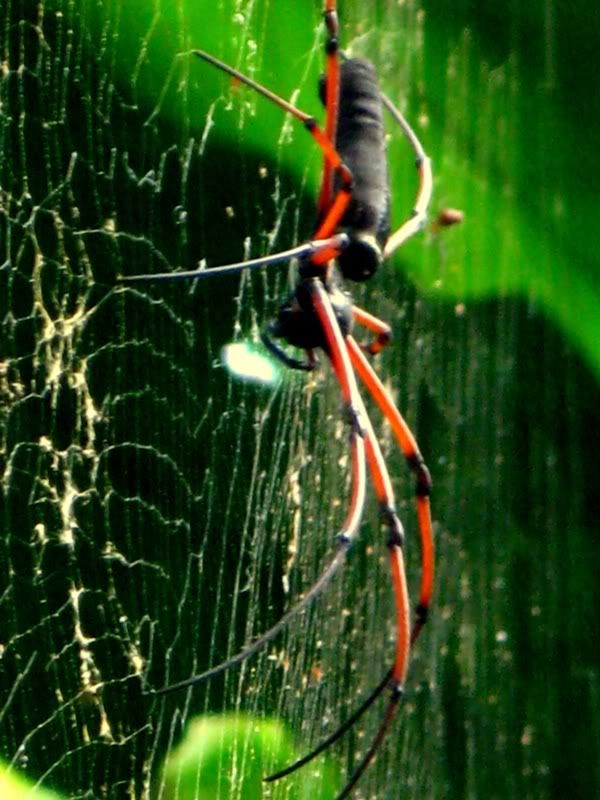
(left): A front view of the spider. This was the best I could get, any closer and the picture would have turned out blur due to the breeze that was flitting about.
(right): A close-up on the lateral (side) view of the spider. Though their colours are bright, their venom is, in fact, harmless to humans. But that doesn't mean we can bully and bend it to our whim. :3
(right): A close-up on the lateral (side) view of the spider. Though their colours are bright, their venom is, in fact, harmless to humans. But that doesn't mean we can bully and bend it to our whim. :3
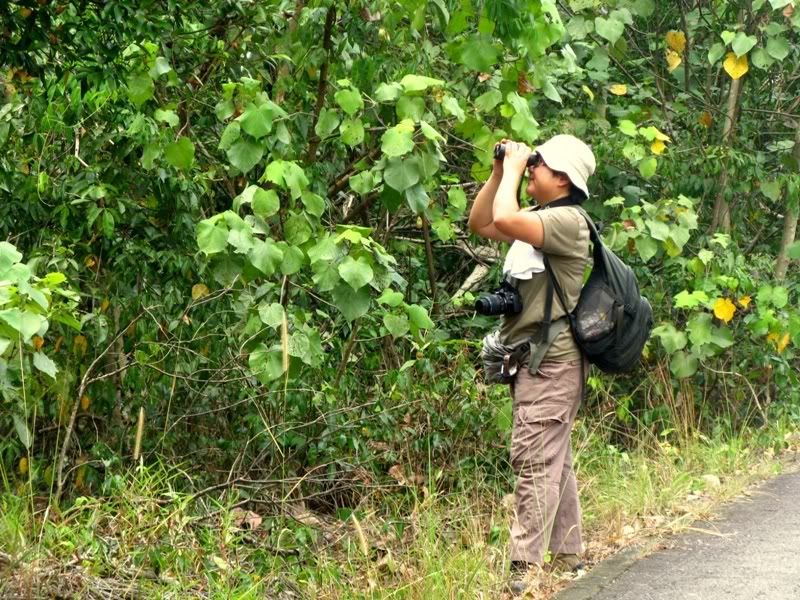 ___
___
(left): LK, an avid bird-watcher and professional ornithologist, on a lookout for birds with her binoculars.
(right): Dollarbirds spotted on a bare tree. Even after zooming 24x, I couldn't really quite capture the hue of this feathered creatures. (here's a clearer image) So called because beneath each wing lies a white, circular patch which the British felt, resembled a dollar. Hence, its name.
(right): Dollarbirds spotted on a bare tree. Even after zooming 24x, I couldn't really quite capture the hue of this feathered creatures. (here's a clearer image) So called because beneath each wing lies a white, circular patch which the British felt, resembled a dollar. Hence, its name.
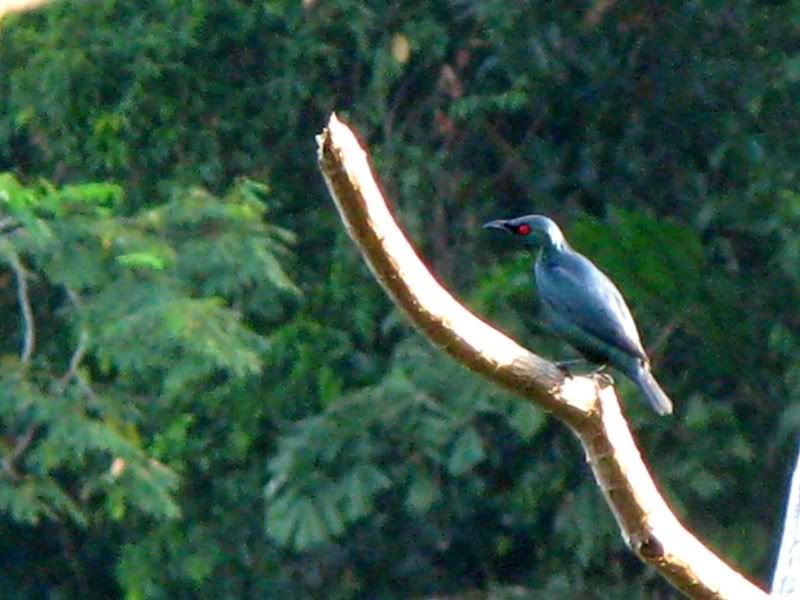 ___
___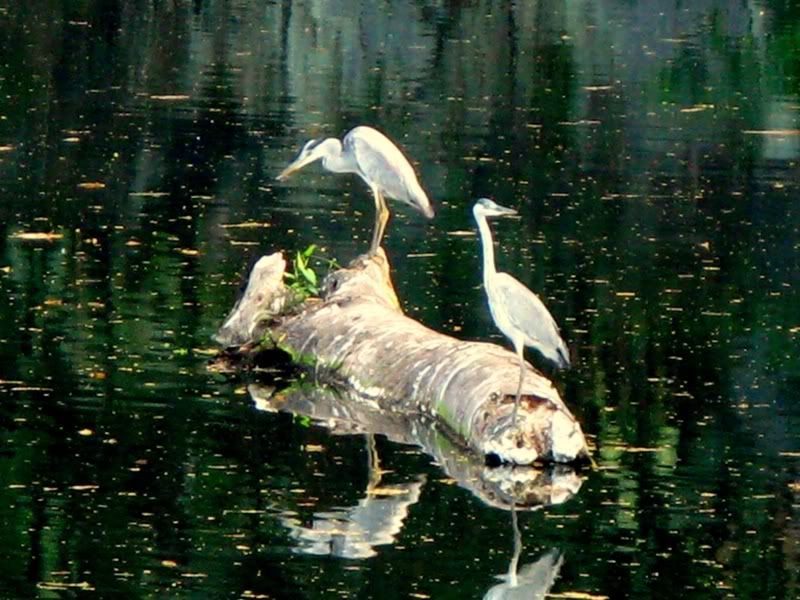
(left): And at a nearby lake (or was it river), an Asian Glossy Starling (Aplonis panayensis) was spotted. So called because of its black, glossy coat that shines when hit by the sun.
(right): And on the log that was floating aimlessly admist the slow currents, perched a couple of grey herons (Ardea cinerea). One with its neck extended and the other in a typical S-shape.
(right): And on the log that was floating aimlessly admist the slow currents, perched a couple of grey herons (Ardea cinerea). One with its neck extended and the other in a typical S-shape.
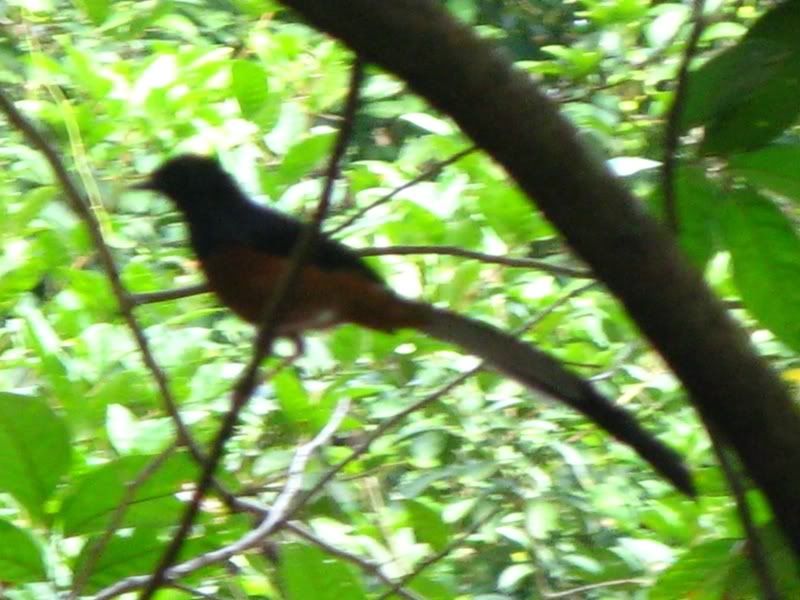 ___
___
(left): But of course, the best and not to mention, rare bird of the day that was spotted was none other than the Shama songster (Copsychus malabaricus).
(right): A clearer view of the bird which song is said to rival the nightingale in richness and versatility. This gorgeous male here has a chestnut underpart with a glossy black head and back. Its rump is white though. [2] The diversity of birds in Pulau Ubin is said to be one of the widest in the entire of Singapore as it consists of many vegetation (though mainly secondary). But this is sufficient to support a large variety of avian species.
(right): A clearer view of the bird which song is said to rival the nightingale in richness and versatility. This gorgeous male here has a chestnut underpart with a glossy black head and back. Its rump is white though. [2] The diversity of birds in Pulau Ubin is said to be one of the widest in the entire of Singapore as it consists of many vegetation (though mainly secondary). But this is sufficient to support a large variety of avian species.
 ___
___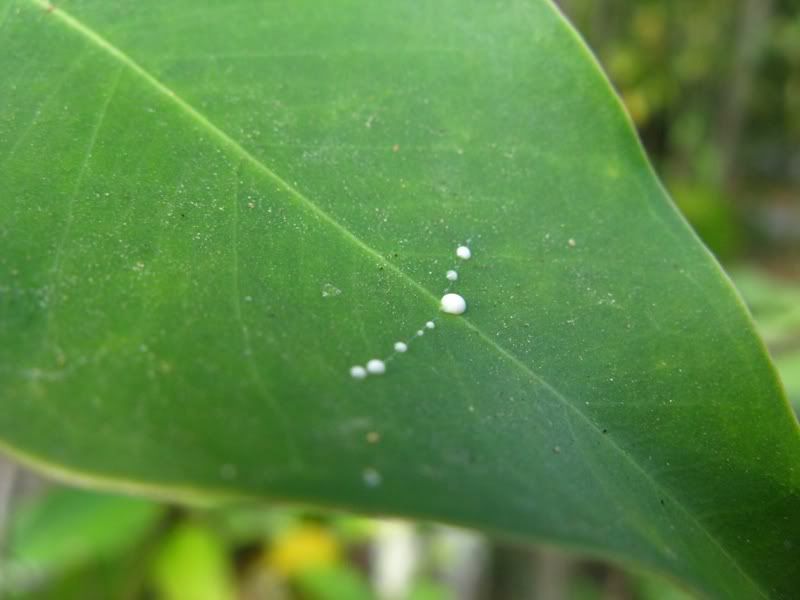
(left): Besides birds and spiders, plants were definitely the main attraction of the day. The first plant which I was quizzed upon was of the fig species from the family Moraceae. Figs can be differentiated from other plants by 3 main features:
1) It has distinctive intrapetiolar scars left behind by the stipules.
--> Intrapetiolar because the stipule (leaflike appendage) is found growing between a petiole (aka leafstalk) and the subtending stem.
2) It has a distinctive stipule. The stipule actually hides the bud of the fig.
3) The leaf when broken or torn produces sap. (colour depends on species)
(right): Evidence that further supports that the plant's a fig.
1) It has distinctive intrapetiolar scars left behind by the stipules.
--> Intrapetiolar because the stipule (leaflike appendage) is found growing between a petiole (aka leafstalk) and the subtending stem.
2) It has a distinctive stipule. The stipule actually hides the bud of the fig.
3) The leaf when broken or torn produces sap. (colour depends on species)
(right): Evidence that further supports that the plant's a fig.
 ___
___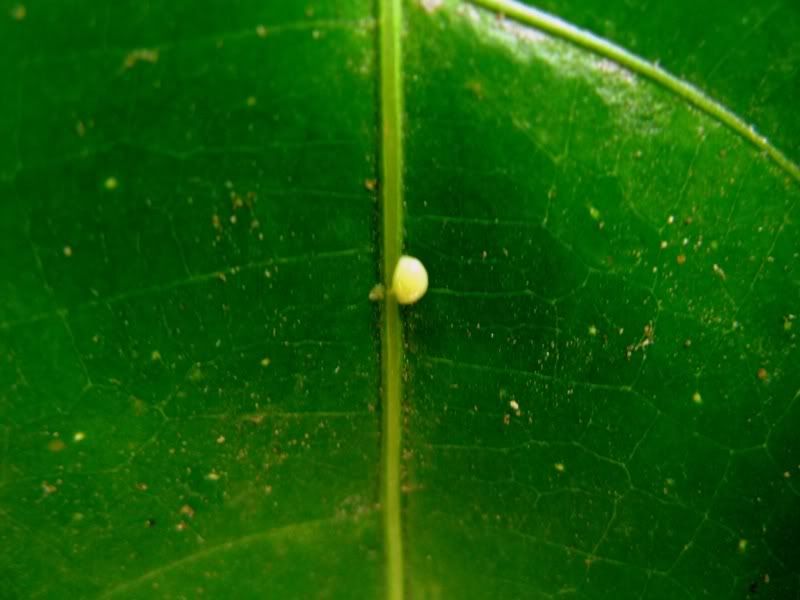
(left): The stipule of the common yellow stem-fig (Ficus fistulosa). Rather sharp and pointy compared to previous one above.
(right): And just as I mentioned, the sap colour of different species can come in a variety of hues, with yellow stem-fig's the colour of pus. -.-
(right): And just as I mentioned, the sap colour of different species can come in a variety of hues, with yellow stem-fig's the colour of pus. -.-
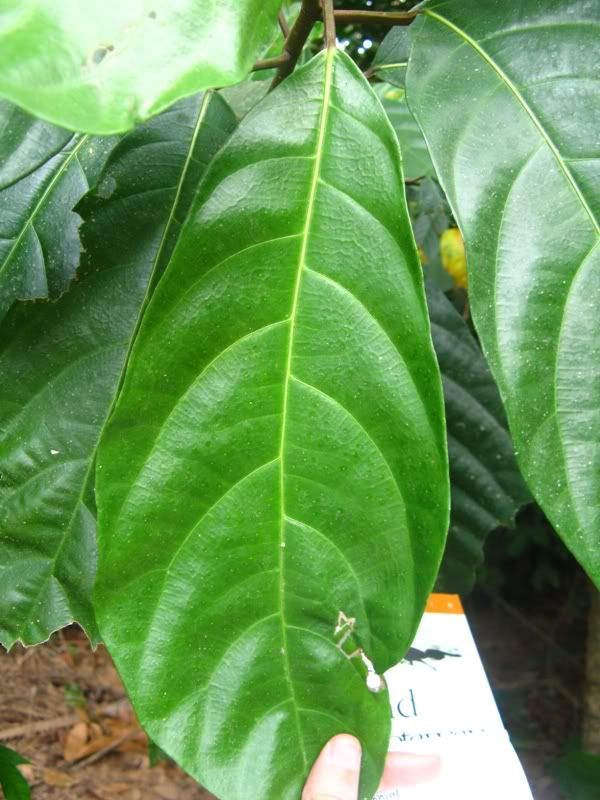 ___
___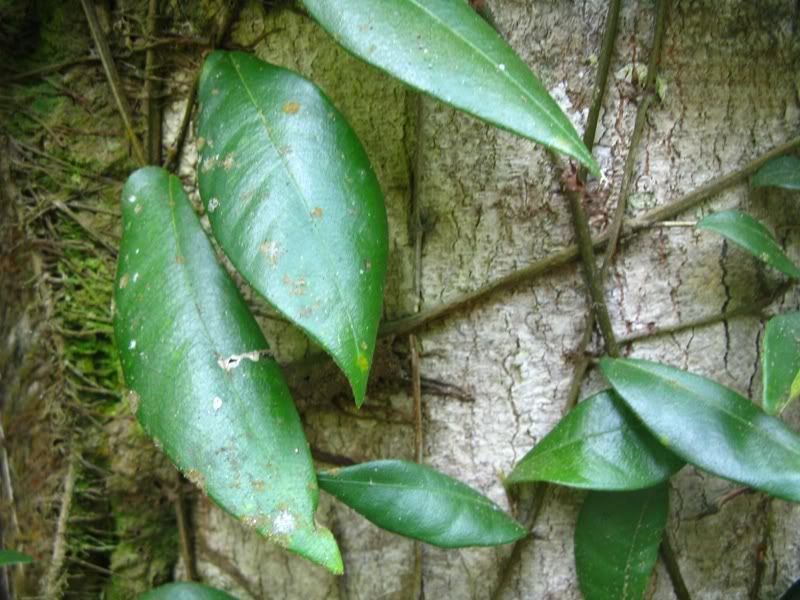
(left): The distinctive elliptical shape of the common yellow stem-fig (Ficus fistulosa).
(right): Other figs that we saw was also the climbing fig. [Edit] Some figs are stranglers by nature, which means, if the seed lands on a branch instead of solid ground, it will slowly send its roots from the top to the bottom. Once there, it then grows upwards and slowly strangles the plant which it initially landed on. But that's only if it lands on a tree instead of solid ground. =) [Edit] However the common yellow stem-fig (Ficus fistulosa) is an exception and is a tree by default.
(right): Other figs that we saw was also the climbing fig. [Edit] Some figs are stranglers by nature, which means, if the seed lands on a branch instead of solid ground, it will slowly send its roots from the top to the bottom. Once there, it then grows upwards and slowly strangles the plant which it initially landed on. But that's only if it lands on a tree instead of solid ground. =) [Edit] However the common yellow stem-fig (Ficus fistulosa) is an exception and is a tree by default.
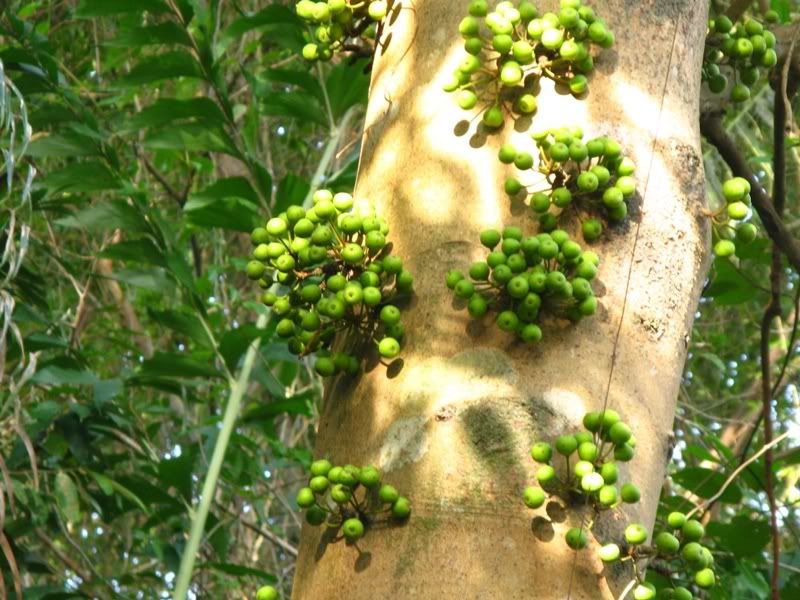 ___
___
(left): And another fig, but this one's a red stem-fig (Ficus variegata).
(right): I was trying to get a picture of the plant that seemed to be snaking its way up a coconut tree. (Ain't sure what plant that was though)
(right): I was trying to get a picture of the plant that seemed to be snaking its way up a coconut tree. (Ain't sure what plant that was though)
 ___
___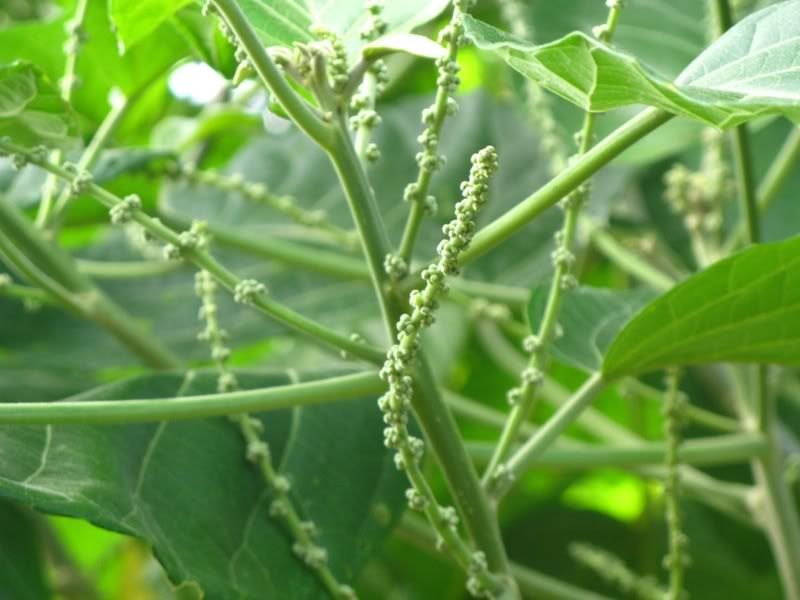
(left): Here's a tree which is locally known as the "Nappy" tree [Edit] (Claoxylon indicum) >__>. Yeah, weird.. but then, the leaf is supposedly to be soft enough to be used as diapers.
(right): The flowers found on the tree.
(right): The flowers found on the tree.
 ___
___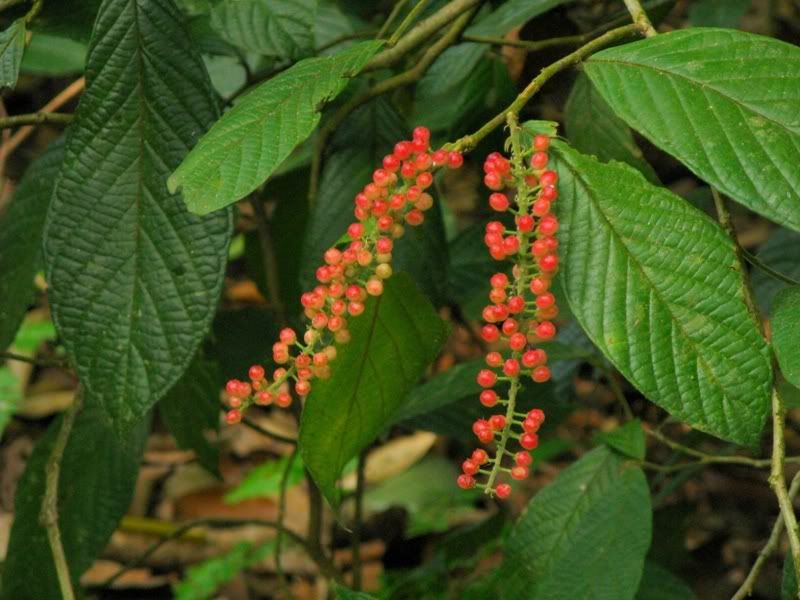
(left): Not sure what is this, but it certainly does remind me of the fluffy (but wired) red decorations that we wind our Chinese New Year tree with. [Edit]: Identity sorted, thanks LK! This plant is none other than the chenille plant or the Red Hot Cat’s Tail (Acalypha hispida). Because of its red, furry flowers, many have cultivated it as a house plant.
(right): [Edit]: The fruit of the Antidesma velutinosum, which plant is endemic to Thailand, Malaysia and Java.
(right): [Edit]: The fruit of the Antidesma velutinosum, which plant is endemic to Thailand, Malaysia and Java.
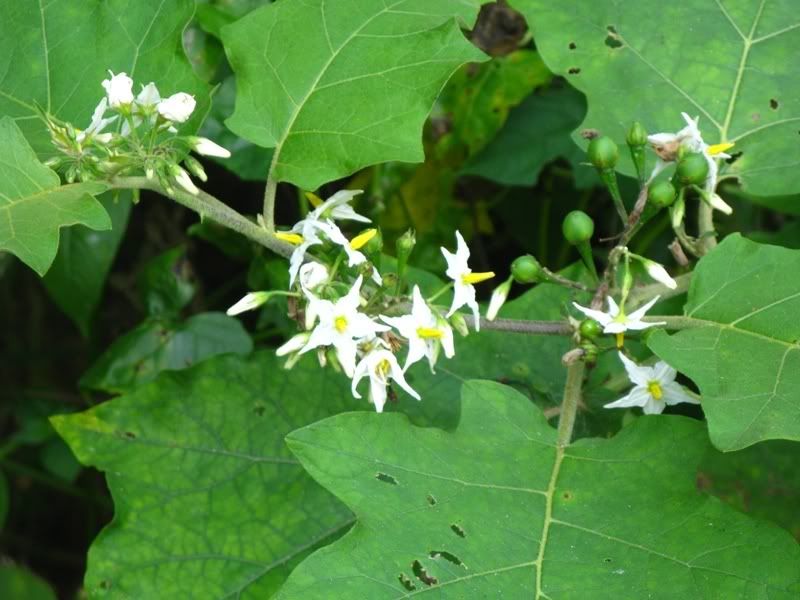 ___
___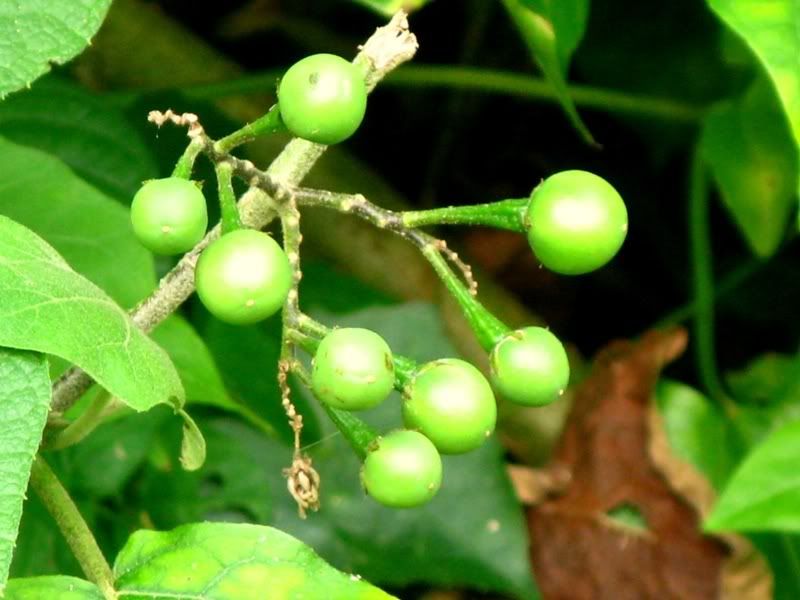
(left): Besides trees of the secondary (forest) variety, there were also fruits, vegetables and flowers which we know and love. The white flowers belong to a wild brinjal [Edit] (Solanum torvum) that seemed to be doing just fine.
(right): The immature fruits of the brinjal plant. Although the Turkey Berry @ Devil's Fig has only been found several times in Florida (introduced sometime before 1900 for cultivation trials,) it has the potential to invade a variety of sites - wet and dry. Once established, it can sprout from the roots, creating large thickets that could displace native vegetation. Turkey berry is found throughout the world’s tropical regions [6] for its horticultural usage as a rootstock for eggplant [7].
(right): The immature fruits of the brinjal plant. Although the Turkey Berry @ Devil's Fig has only been found several times in Florida (introduced sometime before 1900 for cultivation trials,) it has the potential to invade a variety of sites - wet and dry. Once established, it can sprout from the roots, creating large thickets that could displace native vegetation. Turkey berry is found throughout the world’s tropical regions [6] for its horticultural usage as a rootstock for eggplant [7].
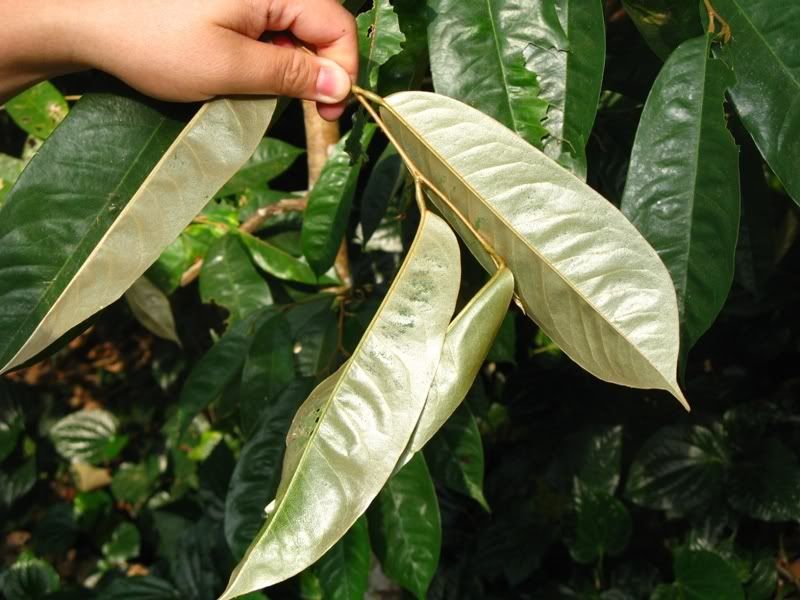 ___
___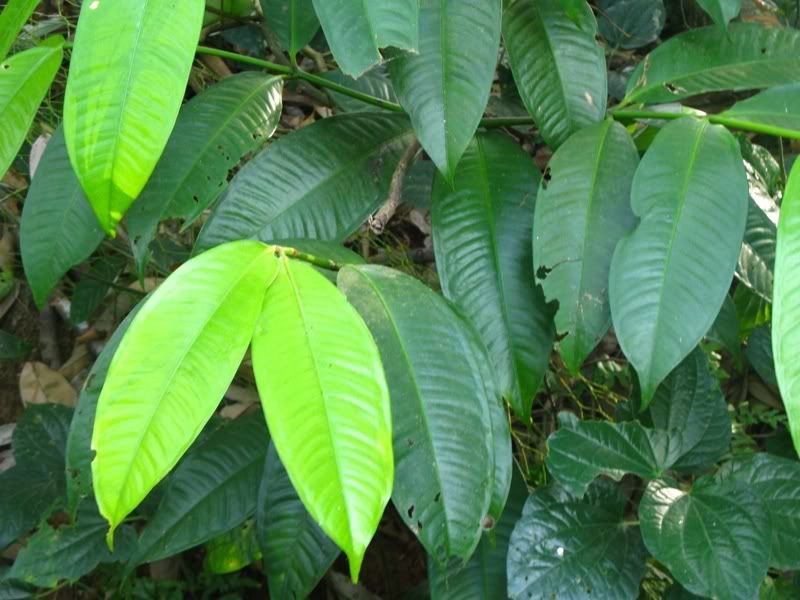
(left): The bronze underside of the leaf which was flipped over belongs to the King of Fruits - the durian (Durio zibethinus).
(right): And not too far off, a mangosteen (Garcinia mangostana) plant was spotted. And of course, it's best to take these after a feast of durian as cools the body.
(right): And not too far off, a mangosteen (Garcinia mangostana) plant was spotted. And of course, it's best to take these after a feast of durian as cools the body.
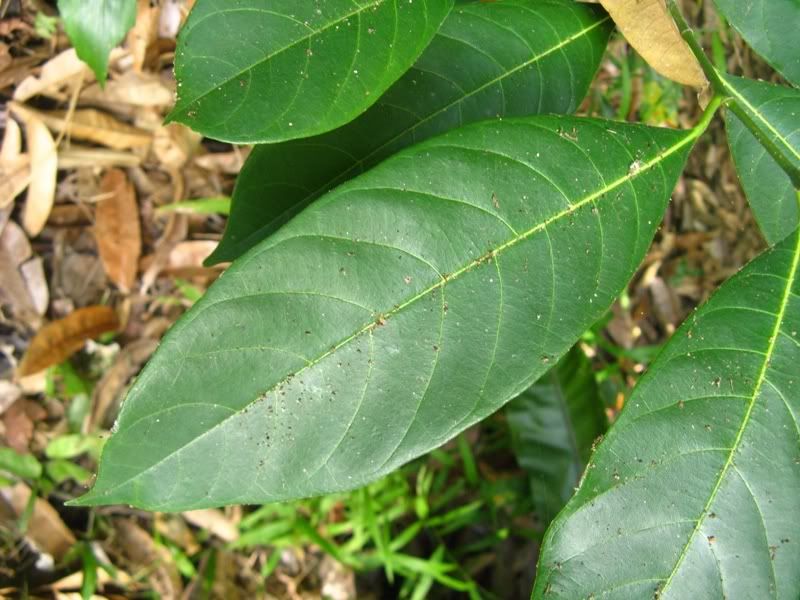 ___
___
(left): The leaves of a jackfruit or nangka, a close relative of the cempedak. But instead of rather distinct hairs running along the underside of the leaf, the Artocarpus heterophyllus feels rather 'sandpaper'-ish instead.
(right): Another plant which genus belongs to the Ficus, with this one, the white leaf-fig being the Ficus grossularioides. Apparently, there are approximately [Edit] 48 known native fig species in Singapore and several non-native ones (with over 900 of them worldwide).
(right): Another plant which genus belongs to the Ficus, with this one, the white leaf-fig being the Ficus grossularioides. Apparently, there are approximately [Edit] 48 known native fig species in Singapore and several non-native ones (with over 900 of them worldwide).
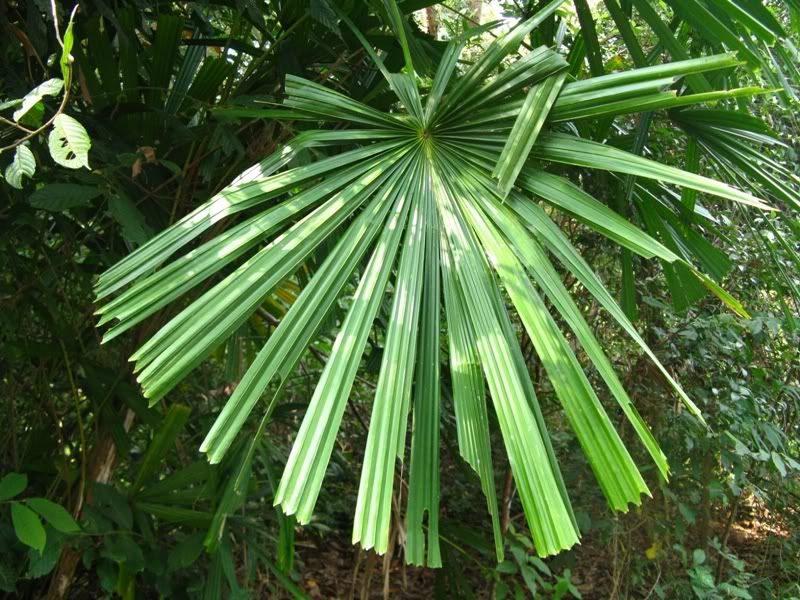 ___
___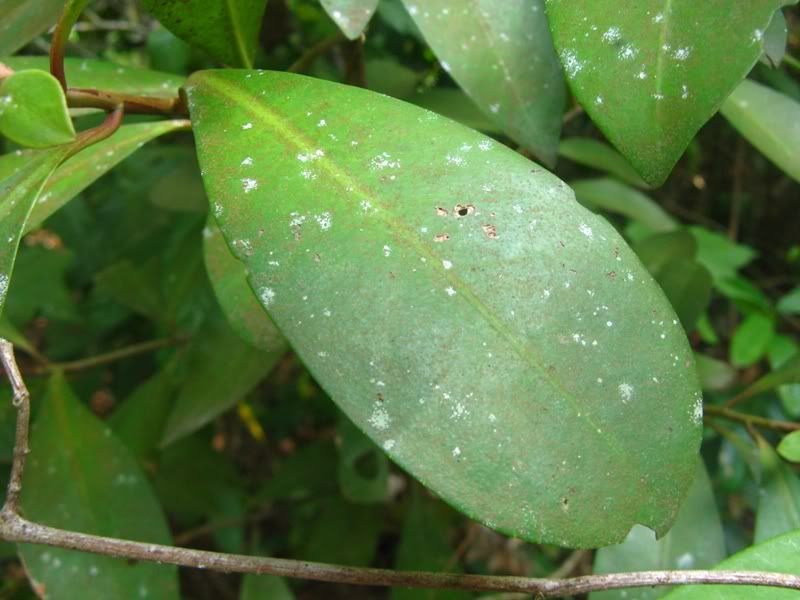
(left): Here's a Fan Palm which is rather large in size. [Edit] For them to reach the mature size like so, it takes many years for they are rather slow-growing. This plant here is a native, coastal species. However due to its unique shape and aesthetic characteristic, it was once nearly poached to extinction.
(right): The reddish tinge that's distinctive of what the locals know as the Mata Ayam [Edit] (Ardisia elliptica) has 2 rather distinguishable features.
1) The leaf possesses a reddish tinge (as known)
2) The end of its leaf stalk is bulged (as can be seen from the picture below)
(right): The reddish tinge that's distinctive of what the locals know as the Mata Ayam [Edit] (Ardisia elliptica) has 2 rather distinguishable features.
1) The leaf possesses a reddish tinge (as known)
2) The end of its leaf stalk is bulged (as can be seen from the picture below)
 ___
___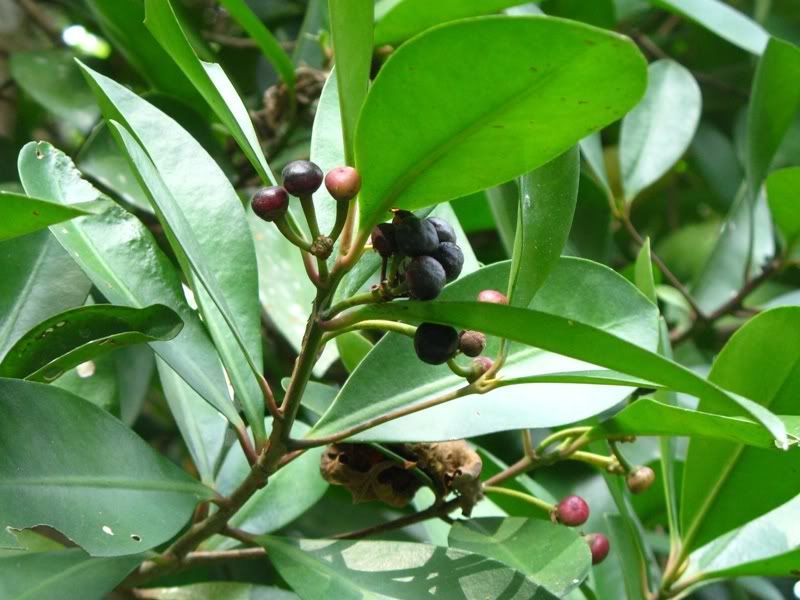
(left): The prominent bulge.
(right): The fruits of the Mata Ayam, which is somehow thought to resemble chickens' eye. Guess the person who came up with this name might have been craving for chicken... :P
(right): The fruits of the Mata Ayam, which is somehow thought to resemble chickens' eye. Guess the person who came up with this name might have been craving for chicken... :P
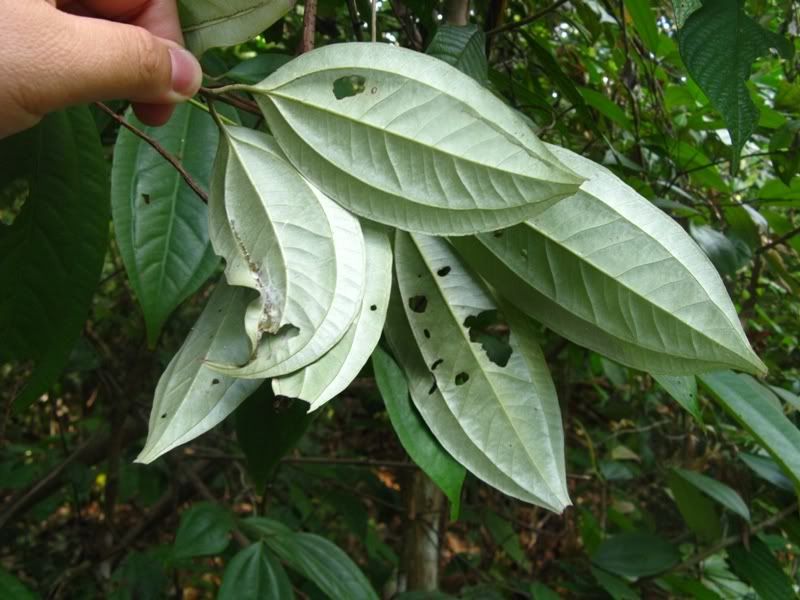 ___
___
(left): There were also some leaves which Ron and LK picked out that were quite pretty. This one's a Silver Back (Rhodamnia cinerea). Yeap, it's exactly like the term given to male gorillas for they sport a silverish patch at the back once adulthood is attained. With 3 longitudinal veins running lengthwise along its leaf, its said to be related to the [Edit] Family Myrtaceae (which gives us our jambu).
(right): Another beauty with its parallel veins (on leaf) so fine and smooth was the Beauty Leaf (Calophyllum inophyllum) aka 'Bintangor'. But this coastal plant isn't all just form, there's function to it too. [Edit] Recently in Borneo, certain species related to the 'Bintangor' (C. coumarins and C. lanigerum) is supposedly found to contain anti-aids properties. Further research and tests are done to verify this. This genus is said to exceed more than a 100 species. It's typically found in the forest.
(right): Another beauty with its parallel veins (on leaf) so fine and smooth was the Beauty Leaf (Calophyllum inophyllum) aka 'Bintangor'. But this coastal plant isn't all just form, there's function to it too. [Edit] Recently in Borneo, certain species related to the 'Bintangor' (C. coumarins and C. lanigerum) is supposedly found to contain anti-aids properties. Further research and tests are done to verify this. This genus is said to exceed more than a 100 species. It's typically found in the forest.
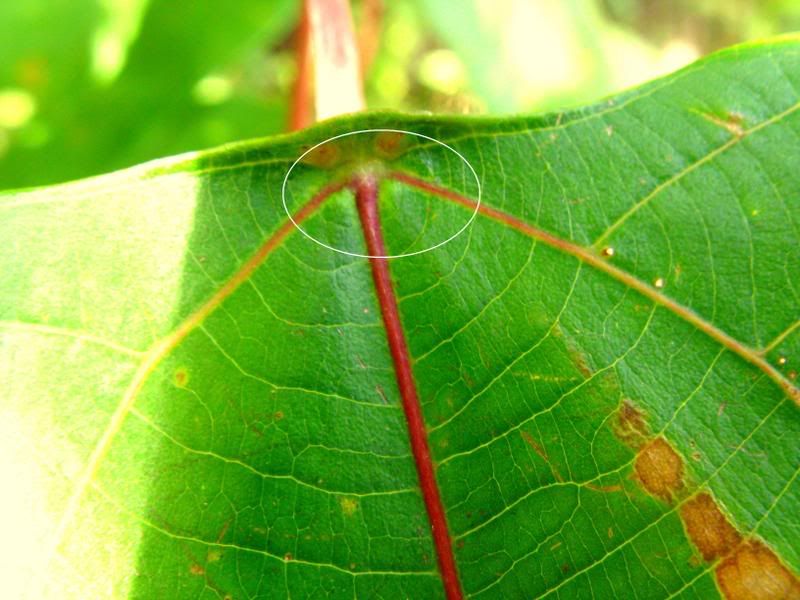 ___
___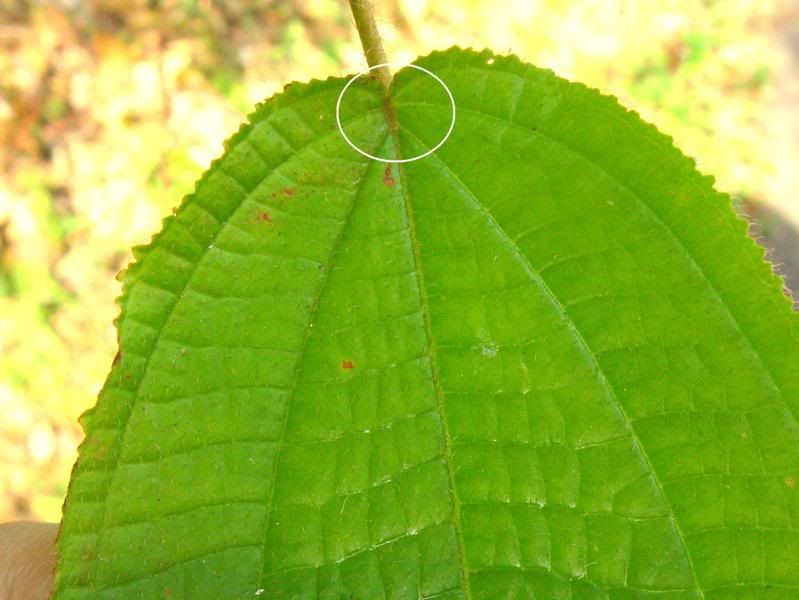
Did you know that there are different varieties for a leafstalk to extend from the end of a leaf?
(left): Here we have the Macaranga which leafstalk does not extend at the edge but instead, extends from the inner part of the leaf. The Macaranga is always found in degraded (infertile) soil where the exposure to sunlight is at its maximum.
(right): On the other hand, the Koster's curse (Clidemia hirta) has its leafstalk extending from the edge. Koster was the man who accidentally introduced the seeds of C. hirta to Fiji in coffee nursery stock between between 1880 and 1886, where its problematic nature (as a noxious weed) was first noticed around 1920 (Paine, 1934; Simmonds, 1937) [3] & [4]. It was originally only known as "the curse" for the damage it did to coconut plantations.
(left): Here we have the Macaranga which leafstalk does not extend at the edge but instead, extends from the inner part of the leaf. The Macaranga is always found in degraded (infertile) soil where the exposure to sunlight is at its maximum.
(right): On the other hand, the Koster's curse (Clidemia hirta) has its leafstalk extending from the edge. Koster was the man who accidentally introduced the seeds of C. hirta to Fiji in coffee nursery stock between between 1880 and 1886, where its problematic nature (as a noxious weed) was first noticed around 1920 (Paine, 1934; Simmonds, 1937) [3] & [4]. It was originally only known as "the curse" for the damage it did to coconut plantations.
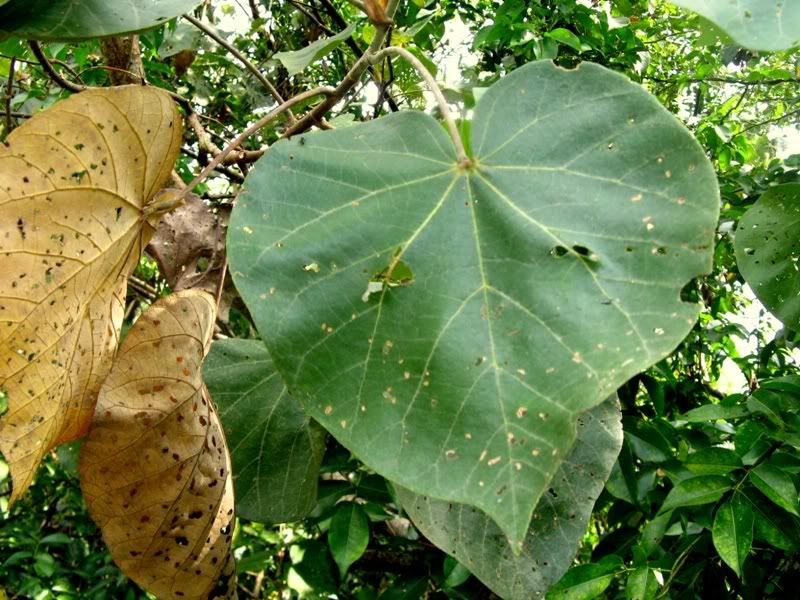 ___
___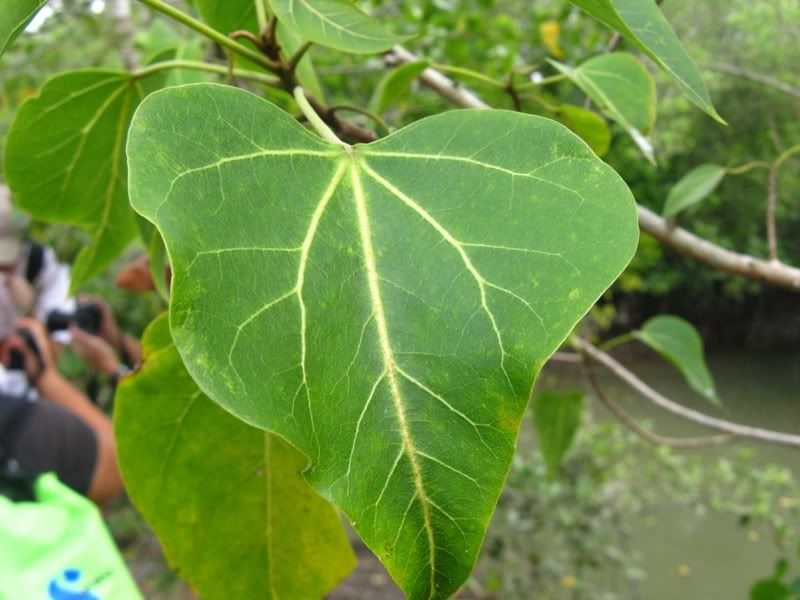
(left): Here's a Sea Hibiscus [Edit] (Talipariti tiliaceum) with its prominent heart-shaped leaf.
(right): But it ain't just the Sea Hibiscus that sports a heart, another mangrove associate can do it just as well. Even so, the Thespesia populnea can be easily distinguished by the distinct creamy white veins on its leaf.
(right): But it ain't just the Sea Hibiscus that sports a heart, another mangrove associate can do it just as well. Even so, the Thespesia populnea can be easily distinguished by the distinct creamy white veins on its leaf.
 ___
___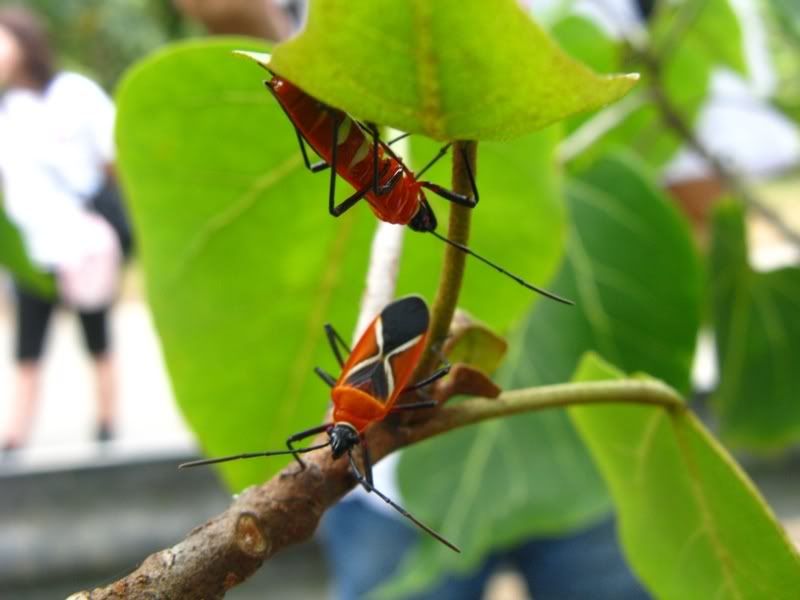
And found residing on some of its leaves were the Thespesia Firebugs (Dysdercus simon). Though they look rather similar to the Cotton Stainer Bugs (Dysdercus decussatus), these 2 can be differentiated by the colour of their heads. The firebugs have a black head while the Cotton Stainers have red ones.
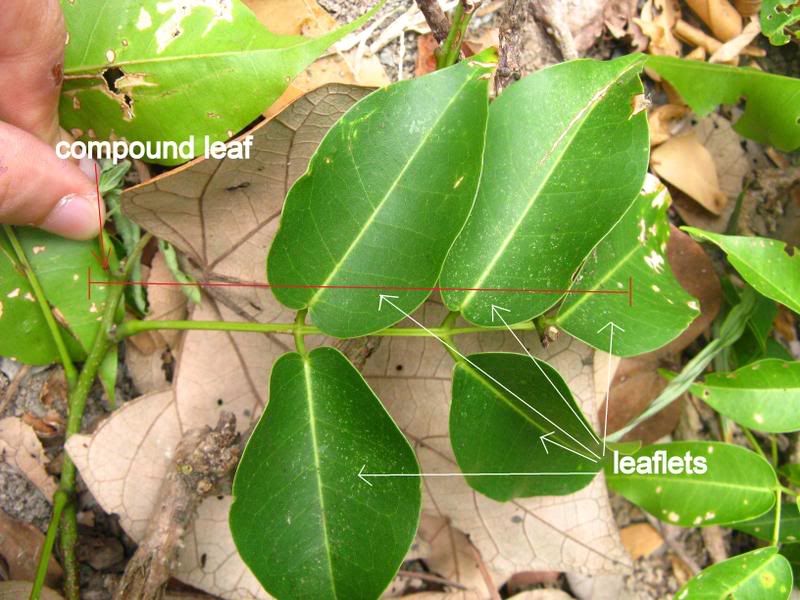 ___
___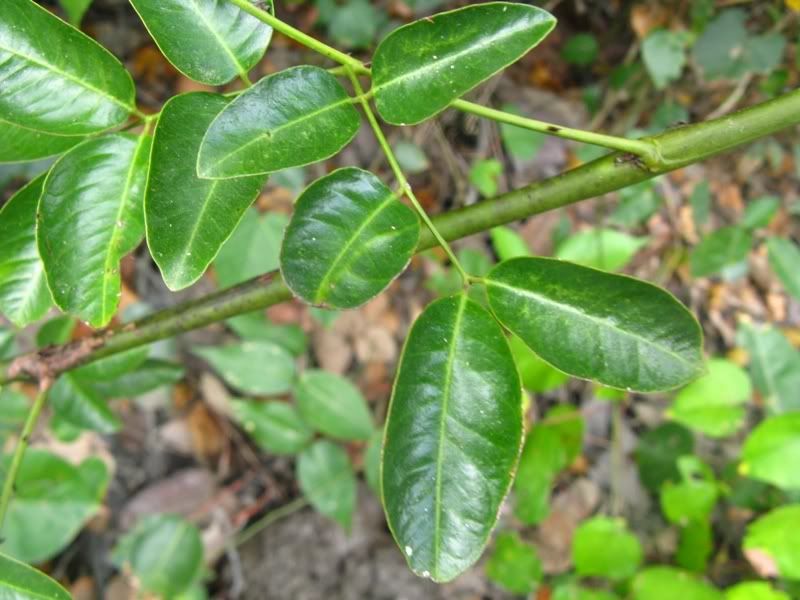
(left): Derris trifoliata which through it I first learn to tell apart a compound leaf from a simple leaf. [A compound leaf contains many leaflets which is connected by the petiole (leafstalk) to the main stem.] How do you tell a simple leaf from a compound one? Easy. Look for the bud! The bud will be on the stem, in the angle between the petiole and the stem [5].
(right): [Edit] Caesalpinia crista or otherwise known as 'She sells peanut'.. lol, is a legume (but how appropriate right?.. for legumes are usually peas or beans) that is found to at the far back of a mangrove habitat. There are altogether 2 Caesalpinia species that can be found in the mangroves, one this and the other being Caesalpinia bonduc, which has distinctively more leaflets.
(right): [Edit] Caesalpinia crista or otherwise known as 'She sells peanut'.. lol, is a legume (but how appropriate right?.. for legumes are usually peas or beans) that is found to at the far back of a mangrove habitat. There are altogether 2 Caesalpinia species that can be found in the mangroves, one this and the other being Caesalpinia bonduc, which has distinctively more leaflets.
 ___
___
(left): Both these 2 are true mangrove ferns. The rounded tops of each leaflet blade are species belonging to the [Edit] Golden Leather Fern (Acrosticum aureum) while pointy tops are the Acrosticum speciosum. They are known under the Genus Acrosticum because their spores are not kept in the sori but scattered unprotected about at the underside of the leaf. And the sori can only be found at the top half of the entire compound leaf.
(right): A closer look at the pointed tops of the leaflets (of the compound leaf) that belongs to Acrosticum speciosum.
(right): A closer look at the pointed tops of the leaflets (of the compound leaf) that belongs to Acrosticum speciosum.
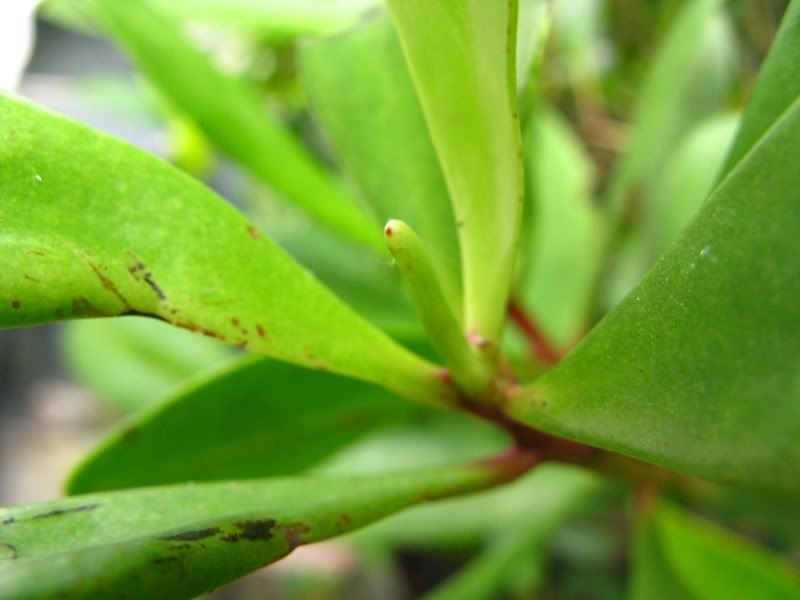 ___
___
(left): A macro shot of the rounded bud belonging to the Lumnitzera littorea. As one can see, the stem of the plant (towards the back) is red in colour. Hence, the flower it produces will also be red in colour. If white, then the blooms will be in that particular hue too.
(right): One way to tell a Lumnitzera littorea apart is that each of the not-so-glossy leaves has a notch at the top and a gland at the back. =) Even though it has a gland on its back, the plant does not secrete the extra salt via this way but through ultrafiltration, in which the salt molecules are prevented from coming in during water uptake by the root membrane.
(right): One way to tell a Lumnitzera littorea apart is that each of the not-so-glossy leaves has a notch at the top and a gland at the back. =) Even though it has a gland on its back, the plant does not secrete the extra salt via this way but through ultrafiltration, in which the salt molecules are prevented from coming in during water uptake by the root membrane.
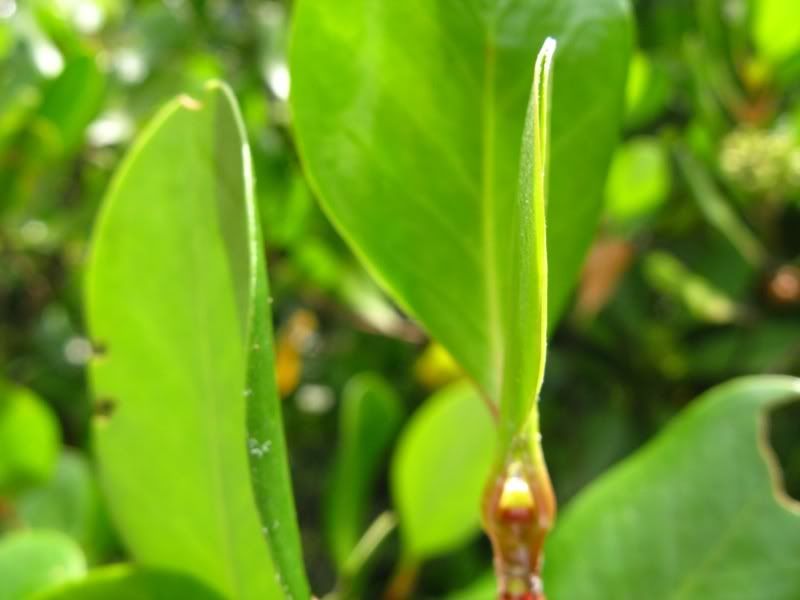 ___
___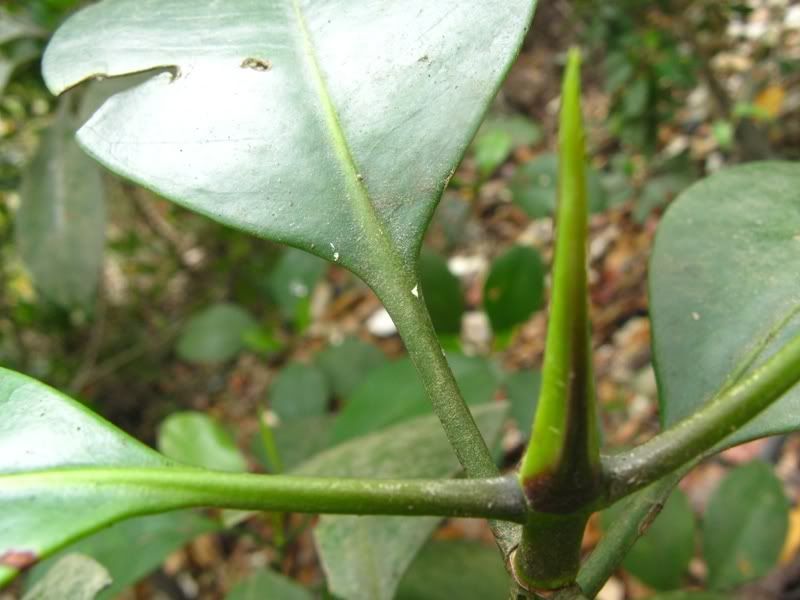
(left): 2 juvenile leaves of the Scyphiphora hydrophyllacea stuck together. It's a common sight when the leaves are still young. The leaves are both thick and glossy as it should be, for the former retains water in the leaves while the latter reflects sunlight of the leaf and thus, reduces transpiration (loss of water). The glossy surface also helps it to survive as a mangrove plant. Salt that crystallizes on the leaves after can be easily swept away by the wind and thus promoting photosynthesis. ^^
(right): Here's also a juvenile bud of the Ceriops sp. that also has its young leaves stuck together (though not as obvious as the previous one). It's also different in the sense that the buds are pointy instead of rounded.
(right): Here's also a juvenile bud of the Ceriops sp. that also has its young leaves stuck together (though not as obvious as the previous one). It's also different in the sense that the buds are pointy instead of rounded.
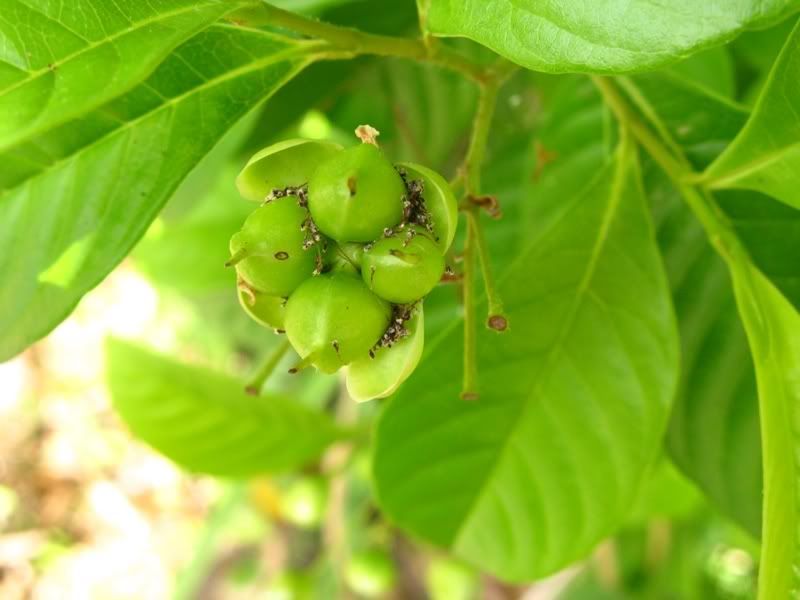 ___
___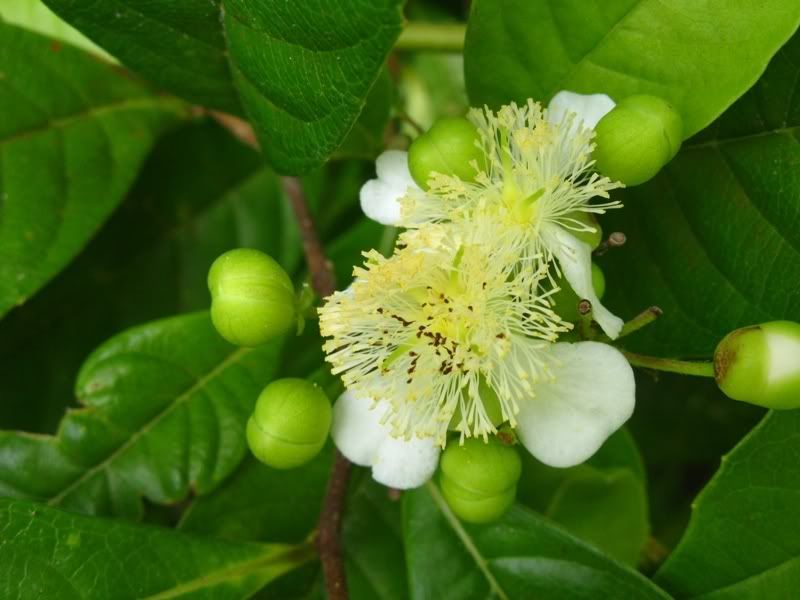
(left): The fruit of the [Edit] Sandpaper Plant (Tetracera indica). So called because the stem of the plant feels rather sandpaper-ish to the touch. And guess what, this plant is in the same family as the Simpoh Air (Dillenia suffruticosa) - Family Dilleniaceae. =)
(right): The flower of the same plant.
(right): The flower of the same plant.
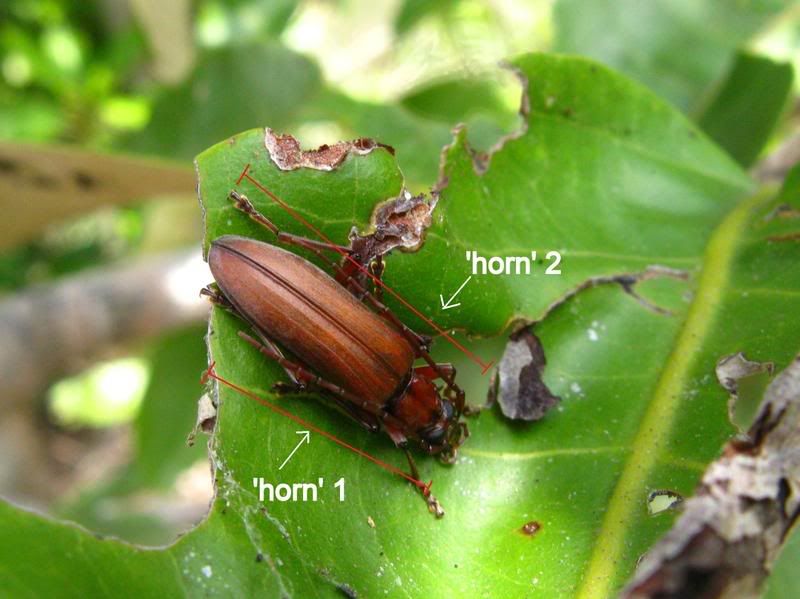 ___
___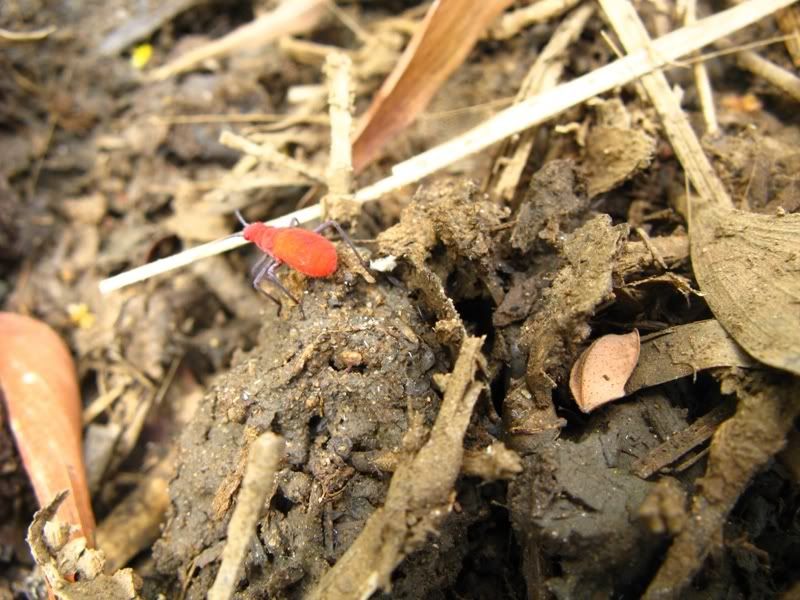
(left): Besides plants, bugs were also rather aplenty, though many of them went unnoticed since we were more focused on the plants. One bug we did see was the Long Horn Beetle from the Family Cerambycidae. Indeed the folded horn or feelers of this lil' guy was as long as its body. O_O
(right): And scurrying on the ground while we were on our way to Noordin Beach was a crimson-pinkish Hopper nymph. Cute. =)
(right): And scurrying on the ground while we were on our way to Noordin Beach was a crimson-pinkish Hopper nymph. Cute. =)
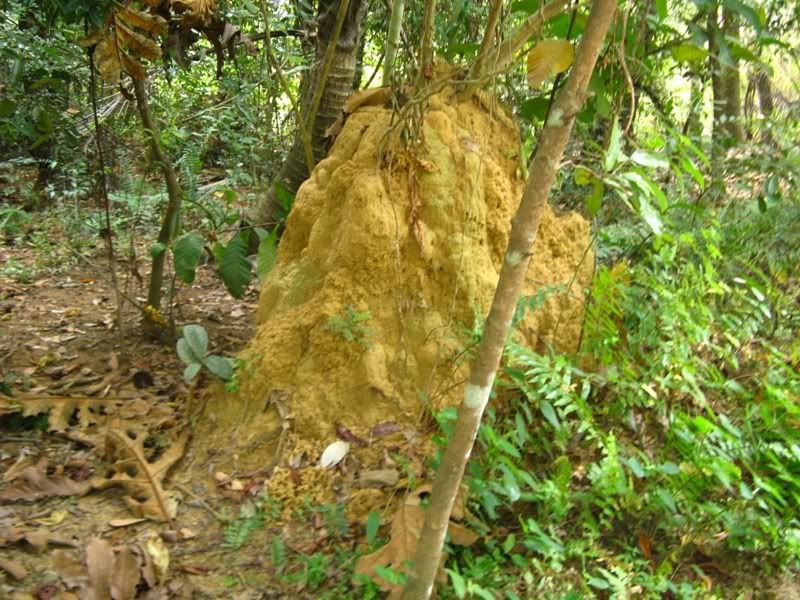 ___
___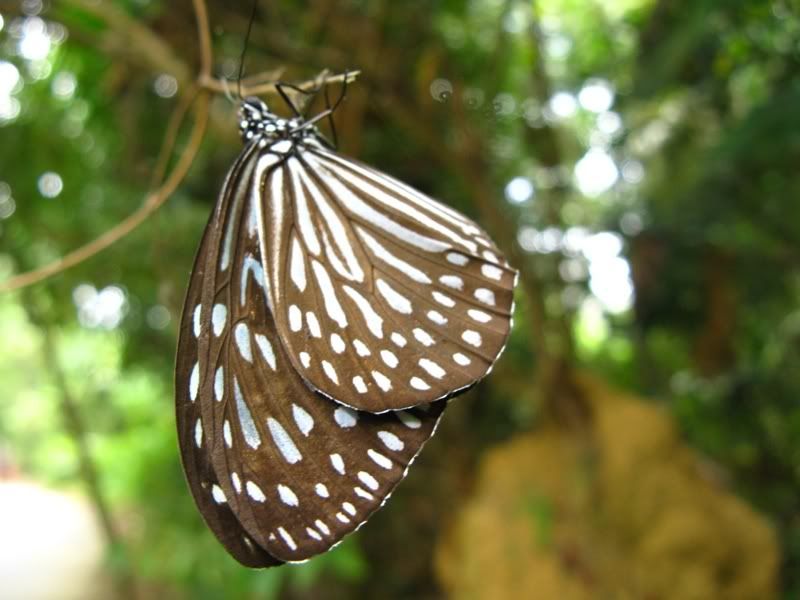
(left): There was also a termite mound which we bumped into. There are also lobster mounds, it looks rather similar except it's made of mud while the termite ones are made of sand.
(right): A butterfly clinging delicately on a vine near the vicinity. And of course with butterflies, there are sure to be caterpillars abound too.
(right): A butterfly clinging delicately on a vine near the vicinity. And of course with butterflies, there are sure to be caterpillars abound too.
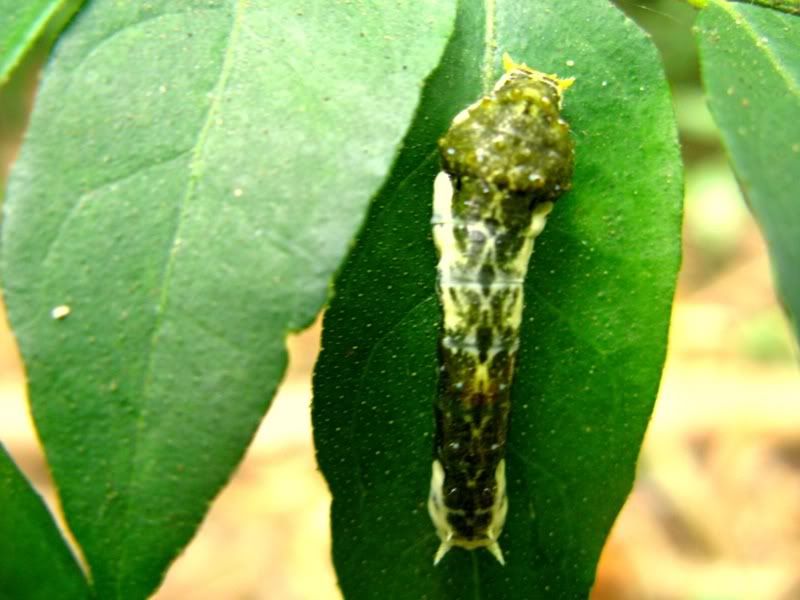 ___
___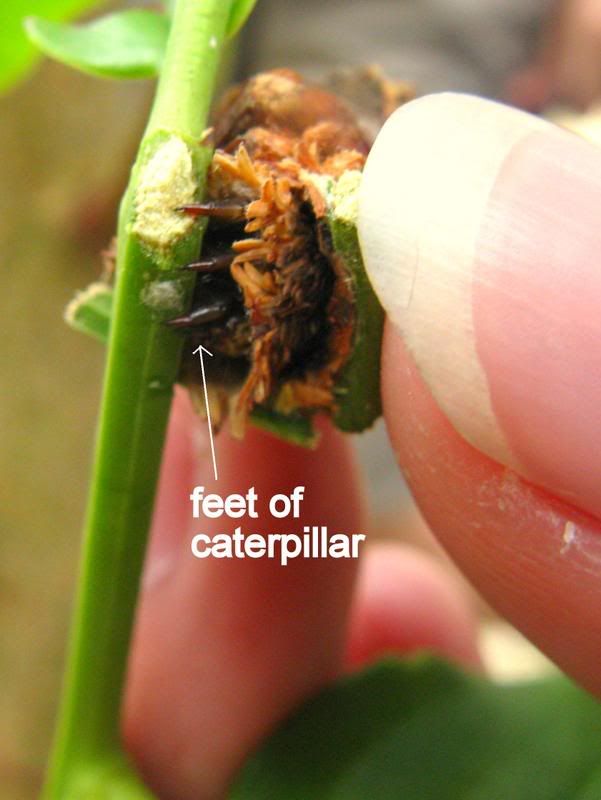
(left): What is known as the Bird Shit Caterpillar. No prizes for guessing what it resembles. :P
(right): And here's another caterpillar which is known as the Bag worm caterpillar. See the feet peeking out?
(right): And here's another caterpillar which is known as the Bag worm caterpillar. See the feet peeking out?
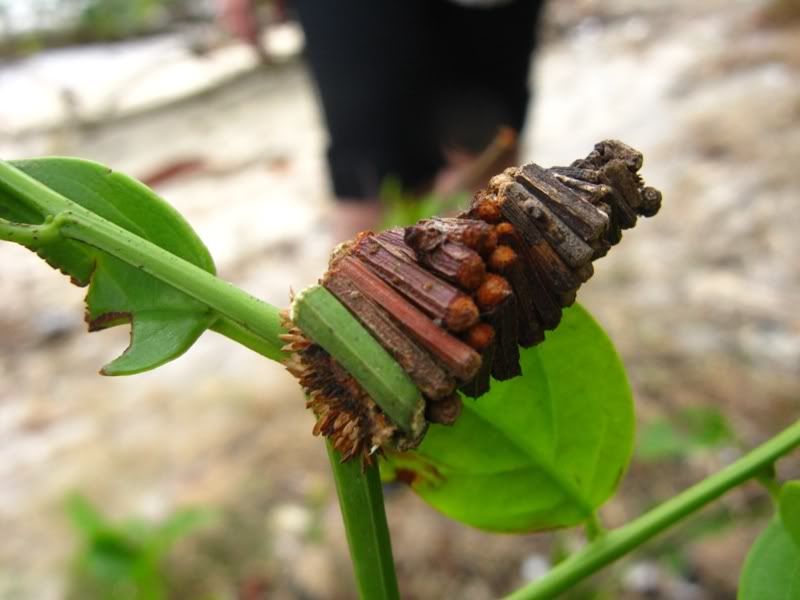 ___
___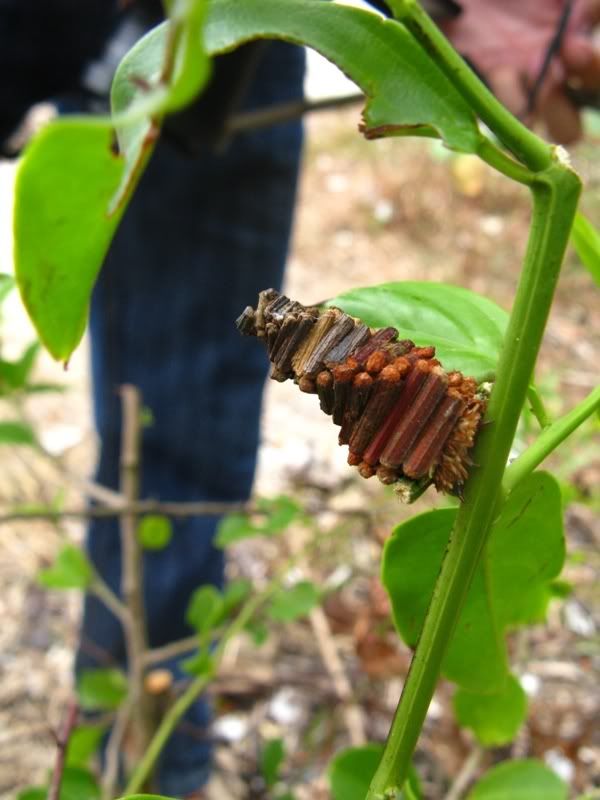
What I thought was static was actually rather motile. Notice its initial location at the crooked corner of the plant (left), after a few minutes it was scurrying deftly down the plant to the current location (right). The "pack" on its bag kinda looks like backpacker's bag, hence the name I presume. This casing is actually tiny twigs glued against each other neatly and then twirled into its current shape with silk. Sweet~~
 ___
___
And finally, after a 4-hour track, we reached Noordin Beach. =) Here's a view of the left and right side of the beach. The skies are pretty clear and the breeze was super-duper refreshing (save for the sight of the rubbish strewn about.. >_<)
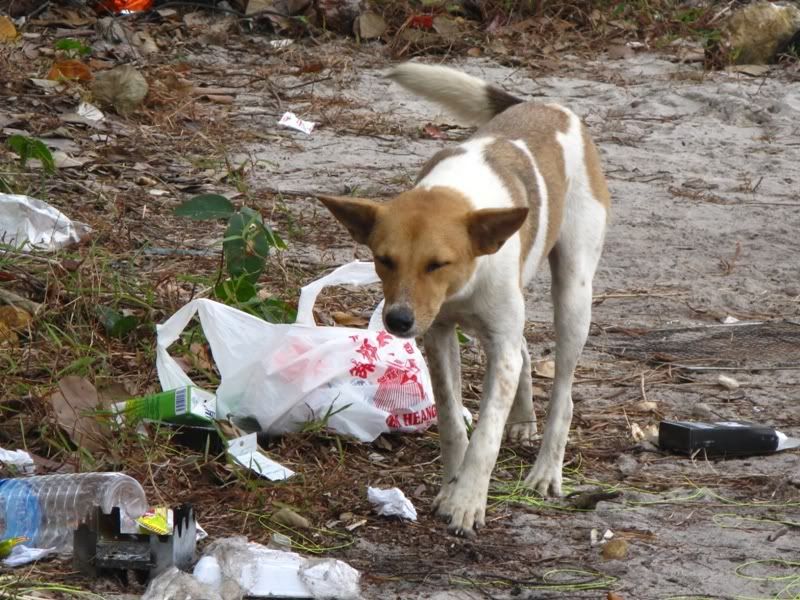 ___
___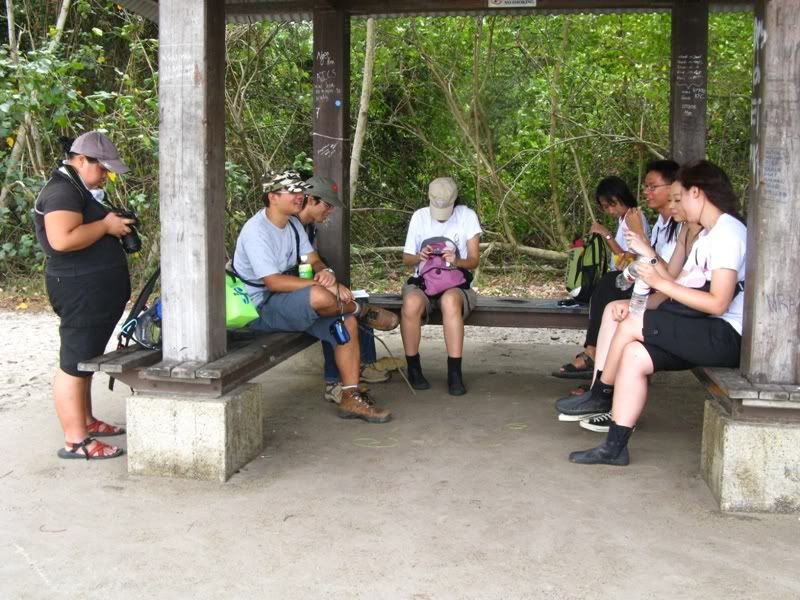
(left): Of course, there are also animals on the beach with one of them being the Canis familiaris aka wild doggies. Here's one who was excited to see company but stayed within a radius of 30cm or so. :P
(right): Time for a long-deserved break with July entertaining us with some of his "jokes". Trust me, it will make you go --> -__-""
(right): Time for a long-deserved break with July entertaining us with some of his "jokes". Trust me, it will make you go --> -__-""
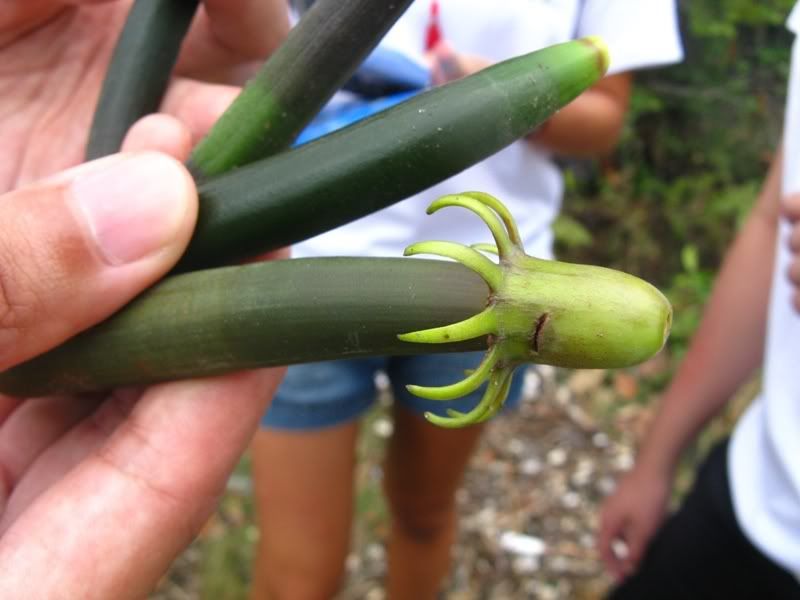 ___
___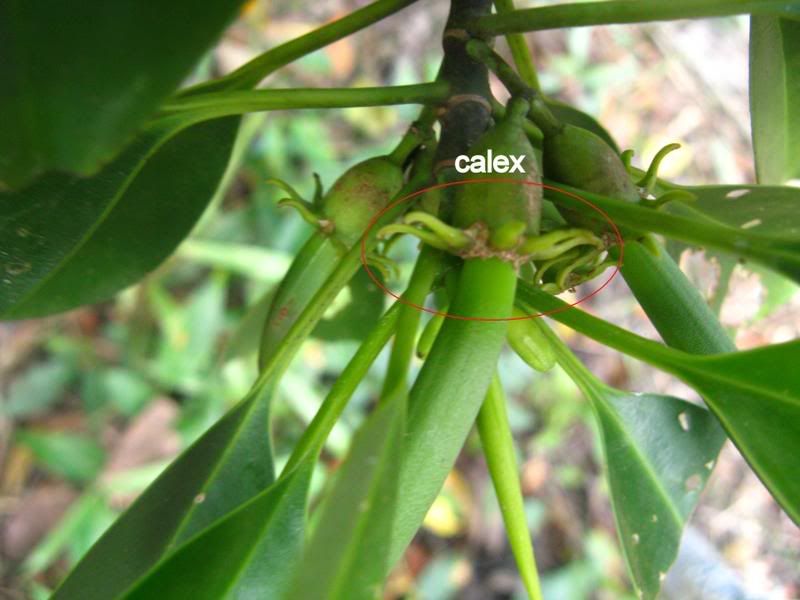
(left): The propagule (germinating fruit of a mangrove plant) belonging to the Bruguiera hainesii. Here the calex of the plant are all pointing downwards.
(right): But this is totally different for the Bruguiera cylindrica which has its calex pointing to the top. The bottom of the propagule (below the calex) is what it's known as the hypocotyl, which will gradually grow into the stem of the juvenile mangrove after leaving its mother plant. The Bruguiera species can be diffentiated from other mangrove genus by the orange knobs that grow on its trunk. There are 2 kinds to the Bruguiera cylindrica, one white and the other red. The red ones are pollinated by sunbirds while the white ones by insects. ^^
(right): But this is totally different for the Bruguiera cylindrica which has its calex pointing to the top. The bottom of the propagule (below the calex) is what it's known as the hypocotyl, which will gradually grow into the stem of the juvenile mangrove after leaving its mother plant. The Bruguiera species can be diffentiated from other mangrove genus by the orange knobs that grow on its trunk. There are 2 kinds to the Bruguiera cylindrica, one white and the other red. The red ones are pollinated by sunbirds while the white ones by insects. ^^
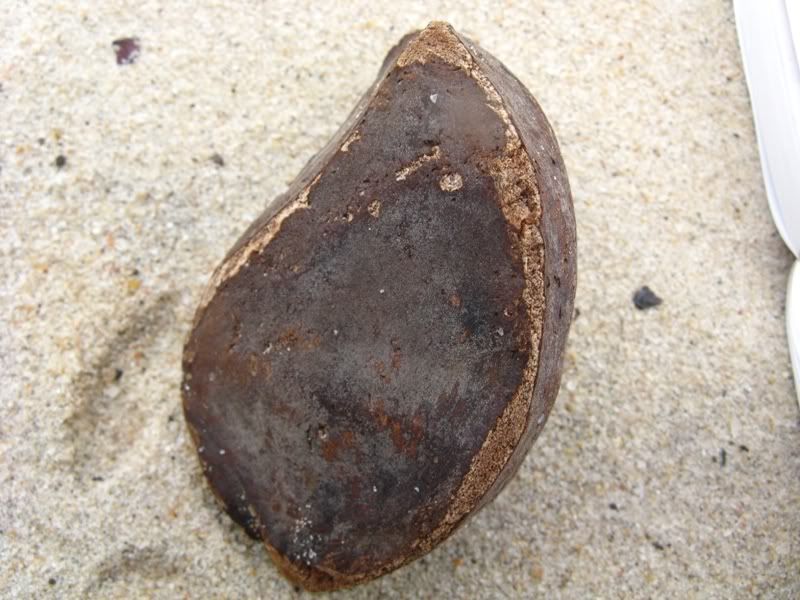 ___
___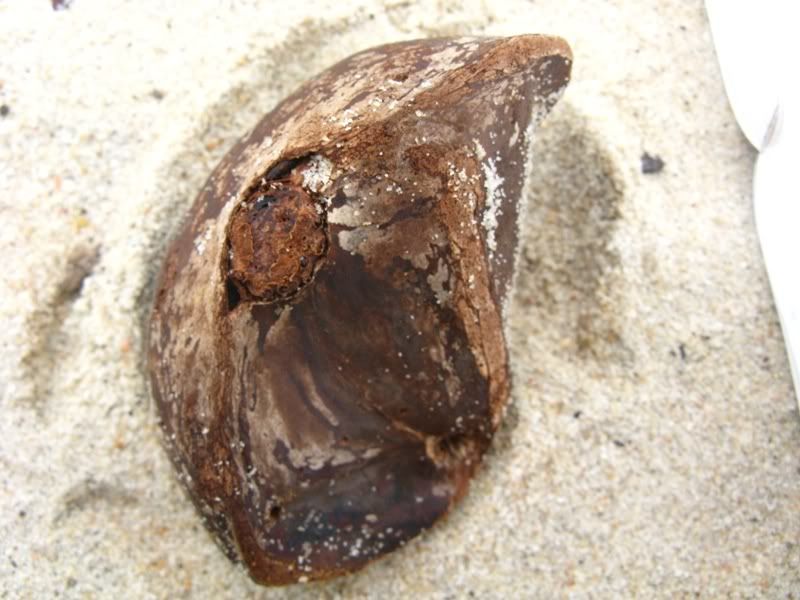
The fruit of the Xylocarpus granatum. The mangrove plant of this fruit has plank-like roots. It's usually found growing at the far back of a mangrove habitat, where the salinity of the soil is low and less moist compared to the soil at the frontier dominated by Rhizophora sp., Avicennia sp. and Sonneratia sp. .
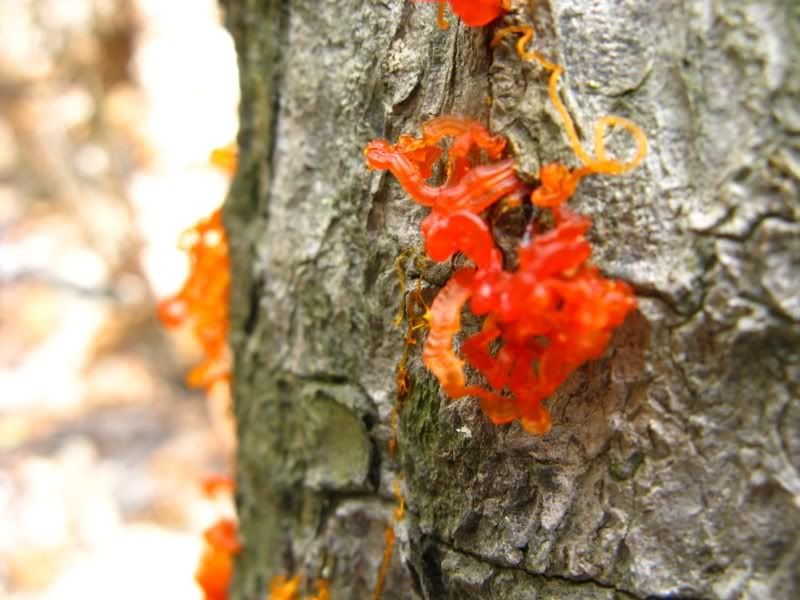 ___
___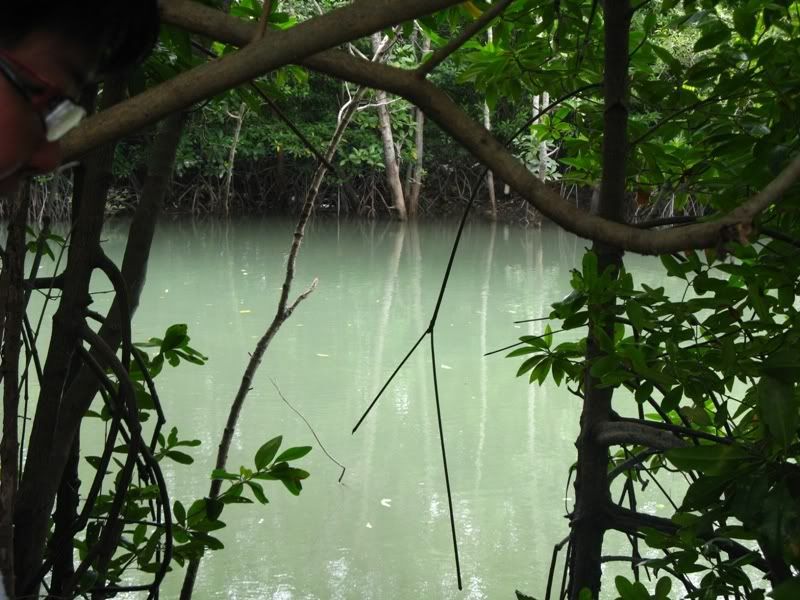
(left): An orange lichen which was found scattered all over a tree trunk. Identity: unknown. (currently searching for it)
(right): A sneak snapshot of the rather clear Sungei Besar.
(right): A sneak snapshot of the rather clear Sungei Besar.
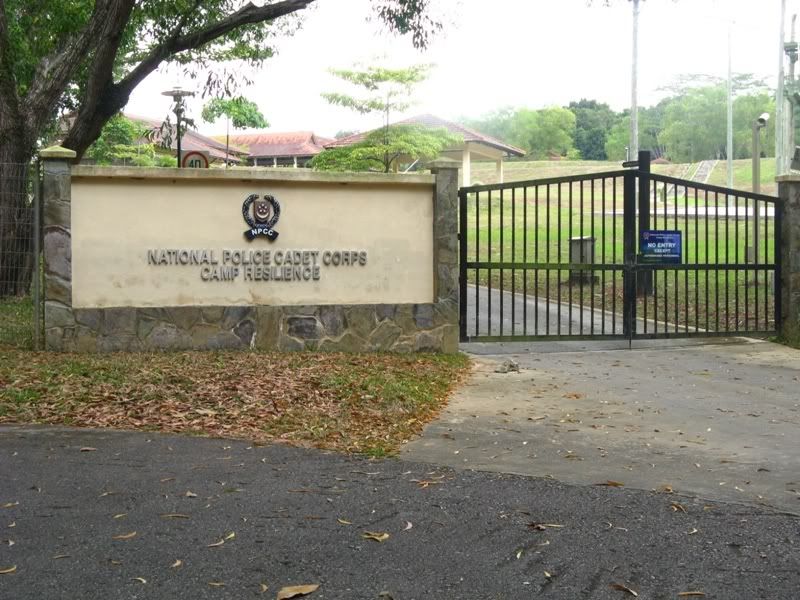 ___
___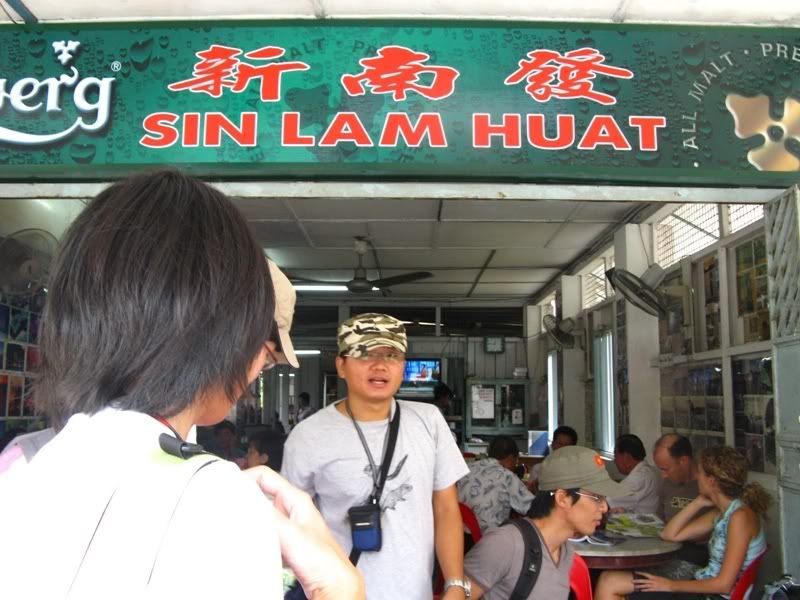
(left): Since most of us were left with just one tiny, critical bar of energy, Ron gave a call and we all waited for the [Edit] local transport service to 'ferry' us back from the (NPCC) National Police Cadet Corps Camp Resilience to the village.
(right): Later on, we had lunch at the Sin Lam Huat. For S$8.35 each, we all had dishes consisting of fried squid (deliciously syiok), spicy kangkung, Kampung chicken in gravy, omelette and tauhu, with a big, cooling jug of lemon ice tea.
(right): Later on, we had lunch at the Sin Lam Huat. For S$8.35 each, we all had dishes consisting of fried squid (deliciously syiok), spicy kangkung, Kampung chicken in gravy, omelette and tauhu, with a big, cooling jug of lemon ice tea.
Lesson learnt:
1) Do not, I repeat, do not wear booties unless urgently needed. It's best to wear thick-soled shoes or hiking shoe wear when walking on a trail or hiking for that matter.
2) Always, always bring some food to sustain yourself throughout the day. (Doesn't matter if it's M&M's, energy bars or just snacks... just as long as there's something to eat and munch, it will do just as good)
** My apologies for the previous mistakes, which has been clarified and rectified.
Thanks LK, Ron & AY for the pointing out the errors! =)
Reference:2) Always, always bring some food to sustain yourself throughout the day. (Doesn't matter if it's M&M's, energy bars or just snacks... just as long as there's something to eat and munch, it will do just as good)
** My apologies for the previous mistakes, which has been clarified and rectified.
Thanks LK, Ron & AY for the pointing out the errors! =)
[1] http://www.naturia.per.sg/buloh/inverts/nephila.htm
[2] http://banglapedia.org/HT/S_0282.HTM
[3] Paine, R.W. (1934): The control of Koster's curse (Clidemia hirta) on Taveuni. Fiji Agricultural Journal 7(1): 10-21.
[4] Simmonds, H. W. (1937): The biological control of the weed Clidemia hirta commonly known in Fiji as 'the curse'. Fiji Agricultural Journal, 8(3): 37–39.
[5] http://learnplantsnow.com/19-basic-botanical-terms/
[6] http://www.invasive.org/browse/subject.cfm?sub=4280
[7] http://en.wikipedia.org/wiki/Solanum_torvum

U are lucky the spiders didnt bite U!!!!
ReplyDeleteBut nice shots of the spiders...for a 10 year old girl, these are pretty spiders..want to catch for collection in the plastic box for exhibit. ^.^
Did u not upload in ur facebook album?!
Luckily u did not pengsan due to lack of glucose and carbs!! Next time stock urself well!! (-__-)
Ur picture layout "lari" it is no more left/right..its more like top and bottom...
ReplyDeleteApa 10 year old girl? Jangan mengada-ngada ya... lol
ReplyDeleteNope.. I have yet to upload it to Facebook but then will do, if I have time..:P
But then, even if the spiders did bite me, it wouldn't hurt cause the venom is harmless to humans.
And about the layout, I think it's because the width and length of your pc that made it lari. It's fine for me wo.. :)